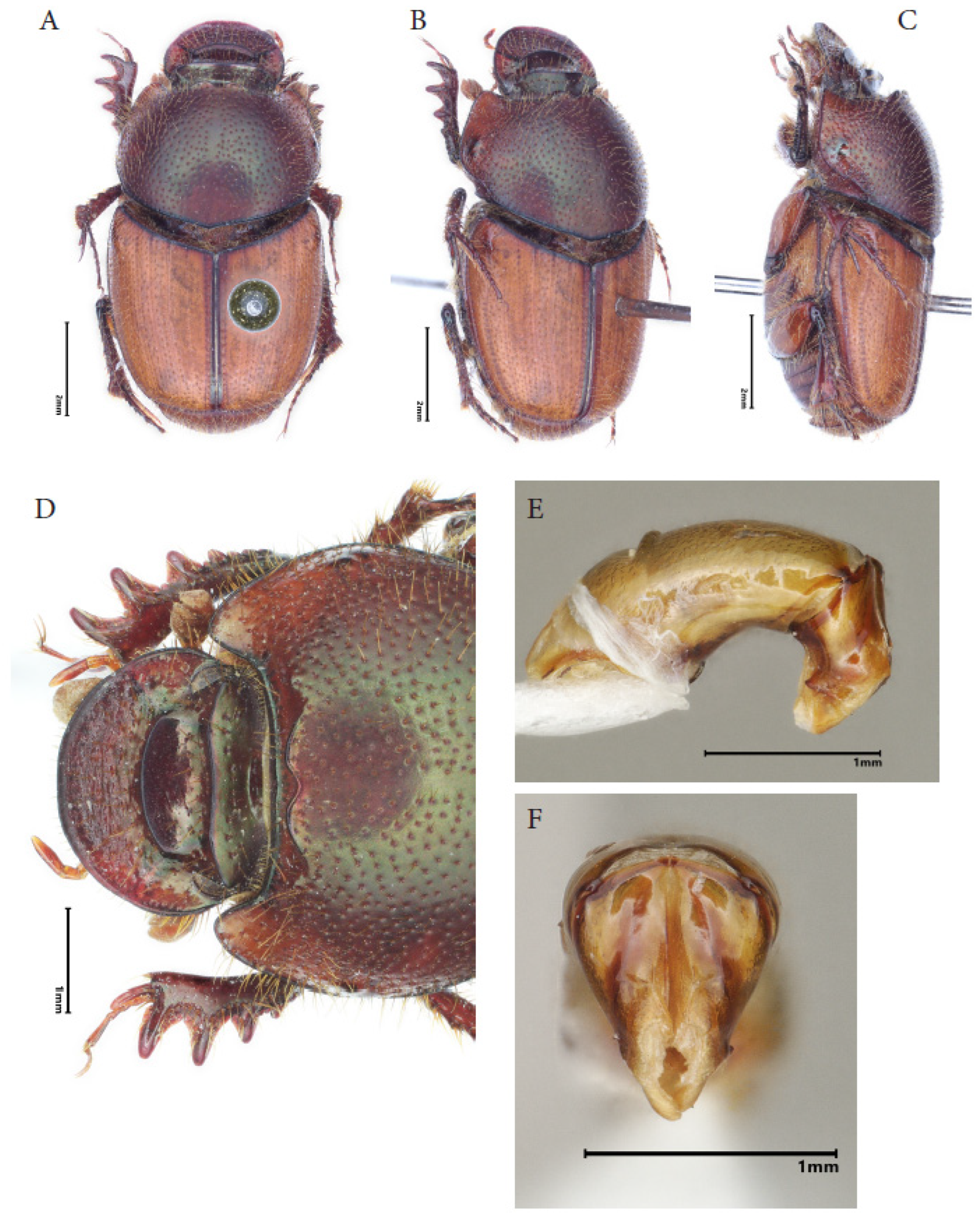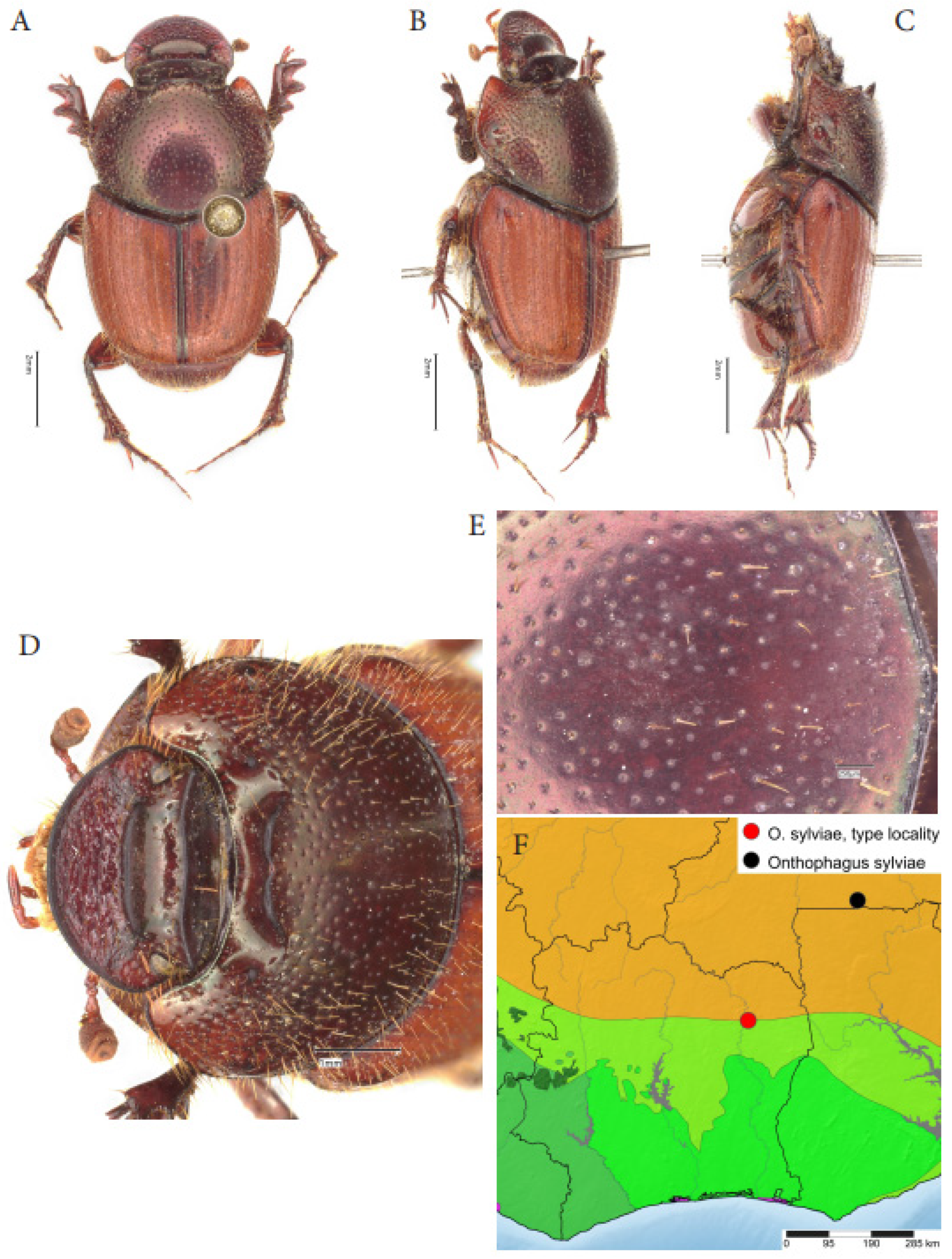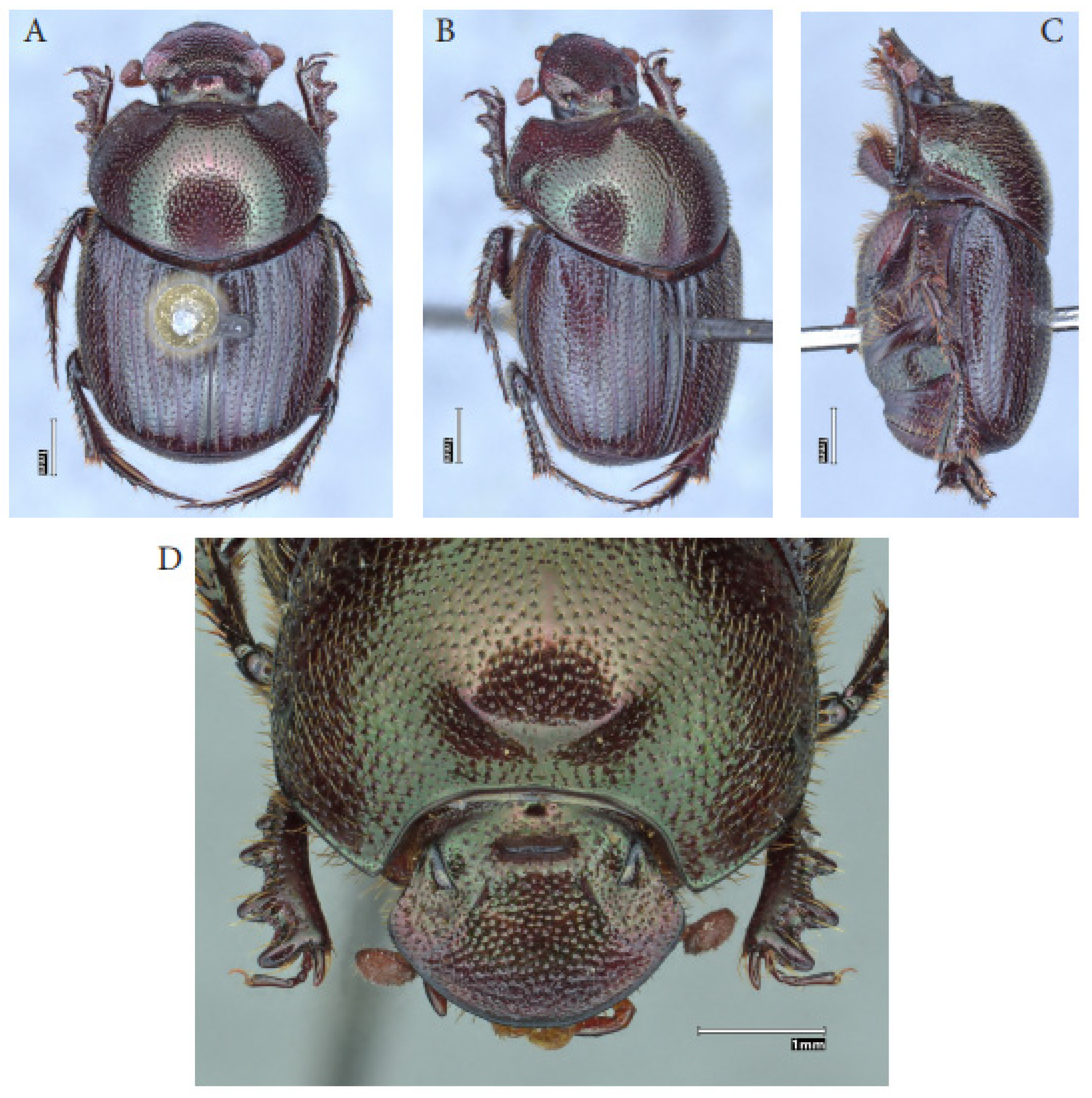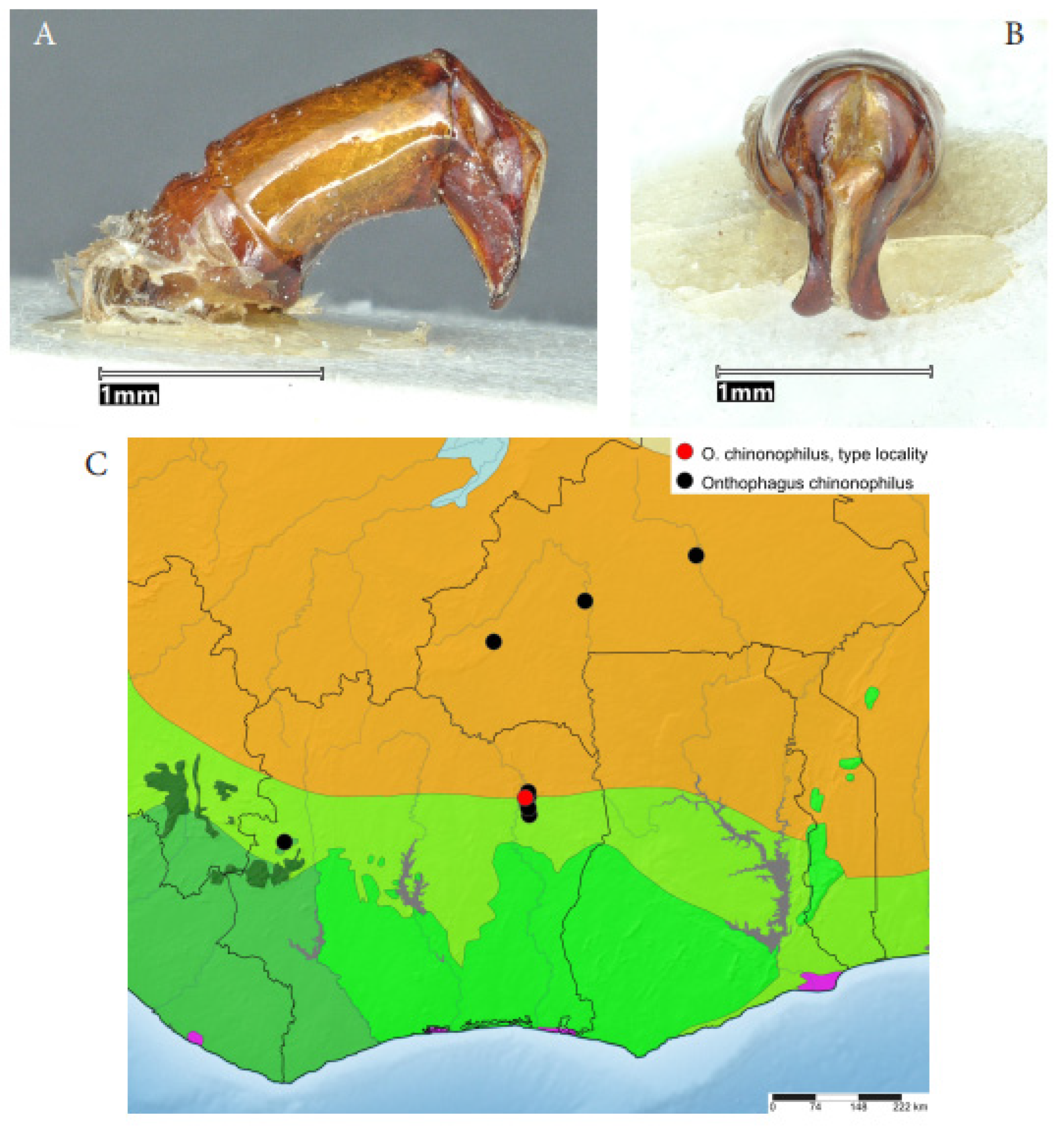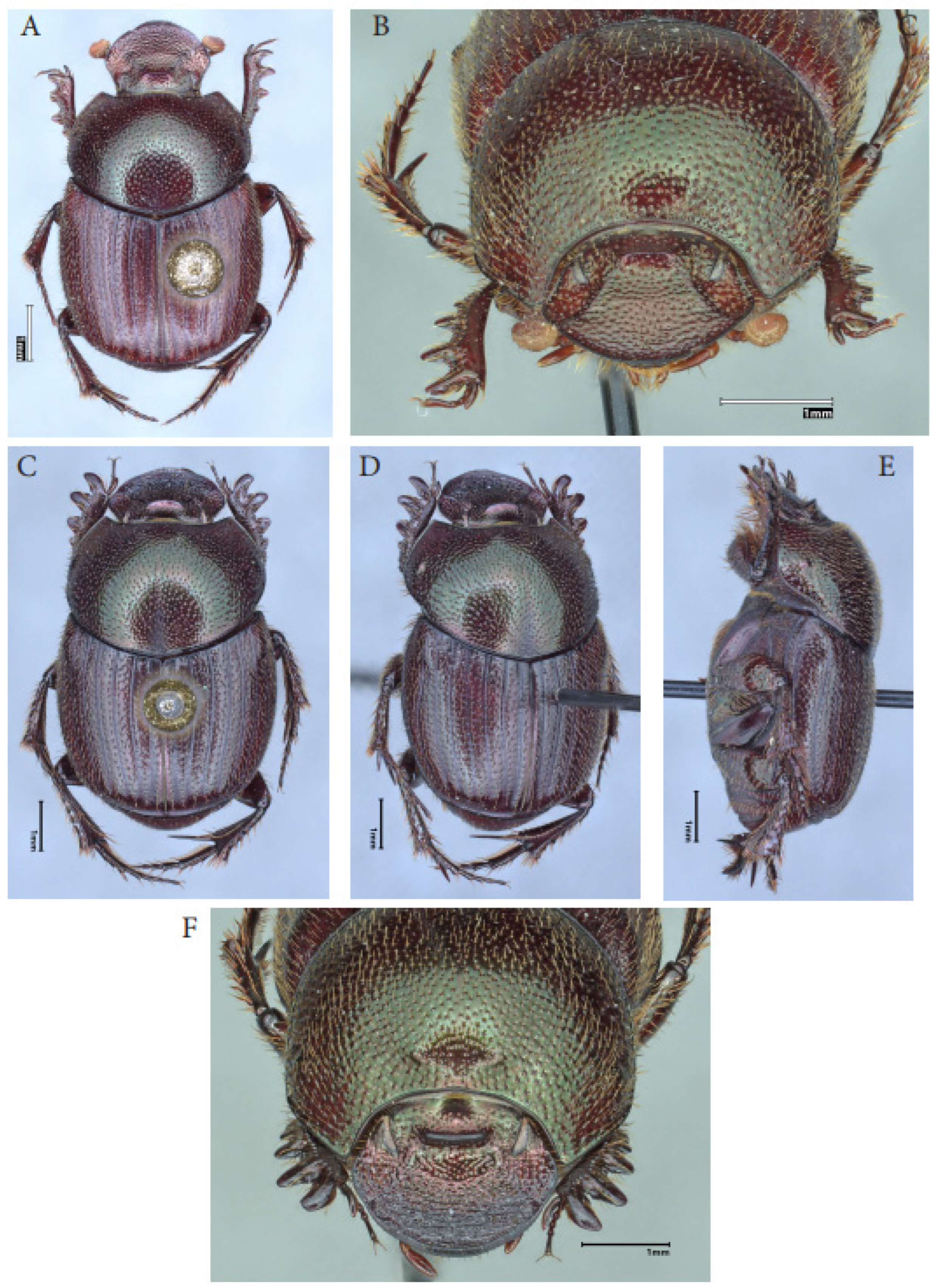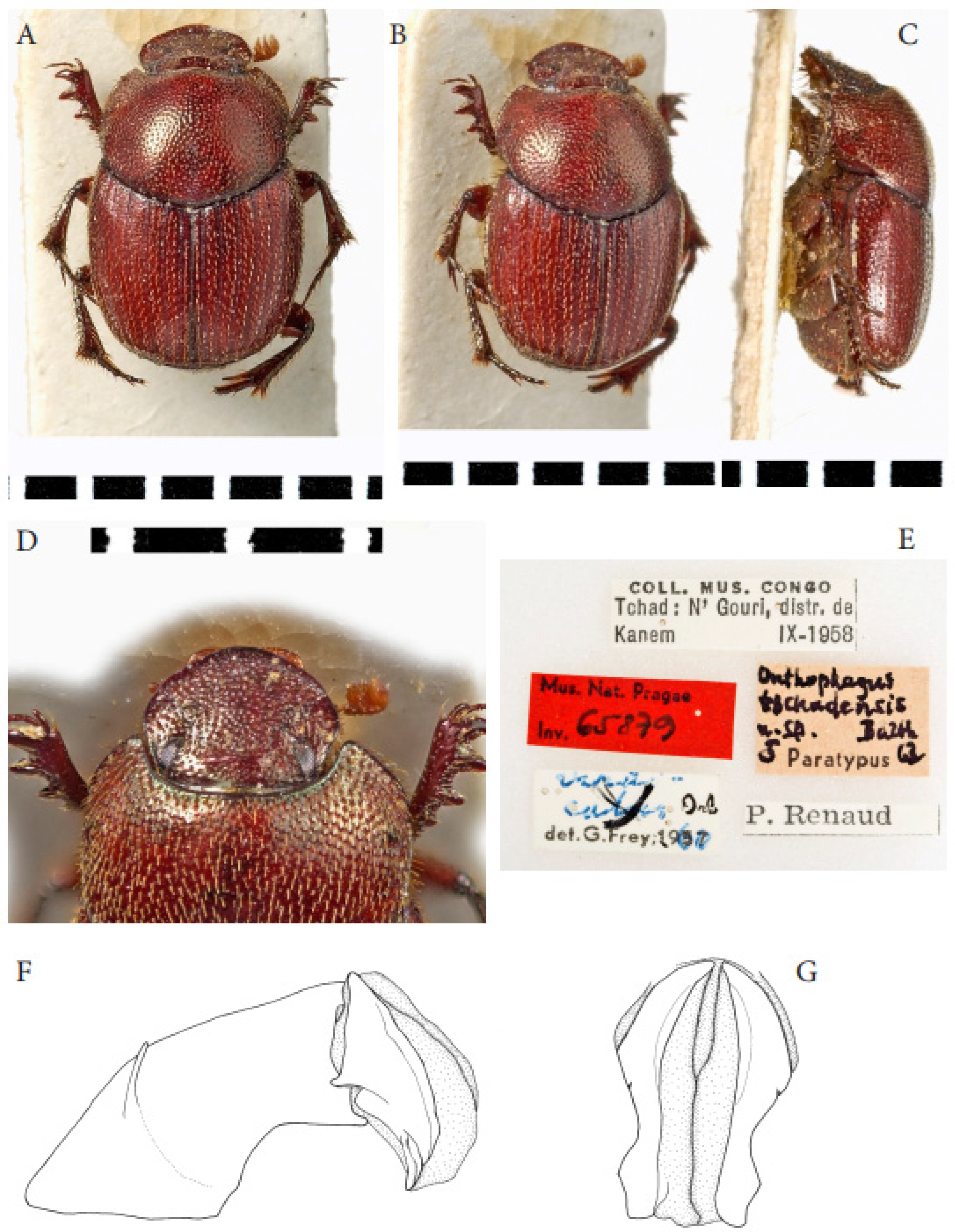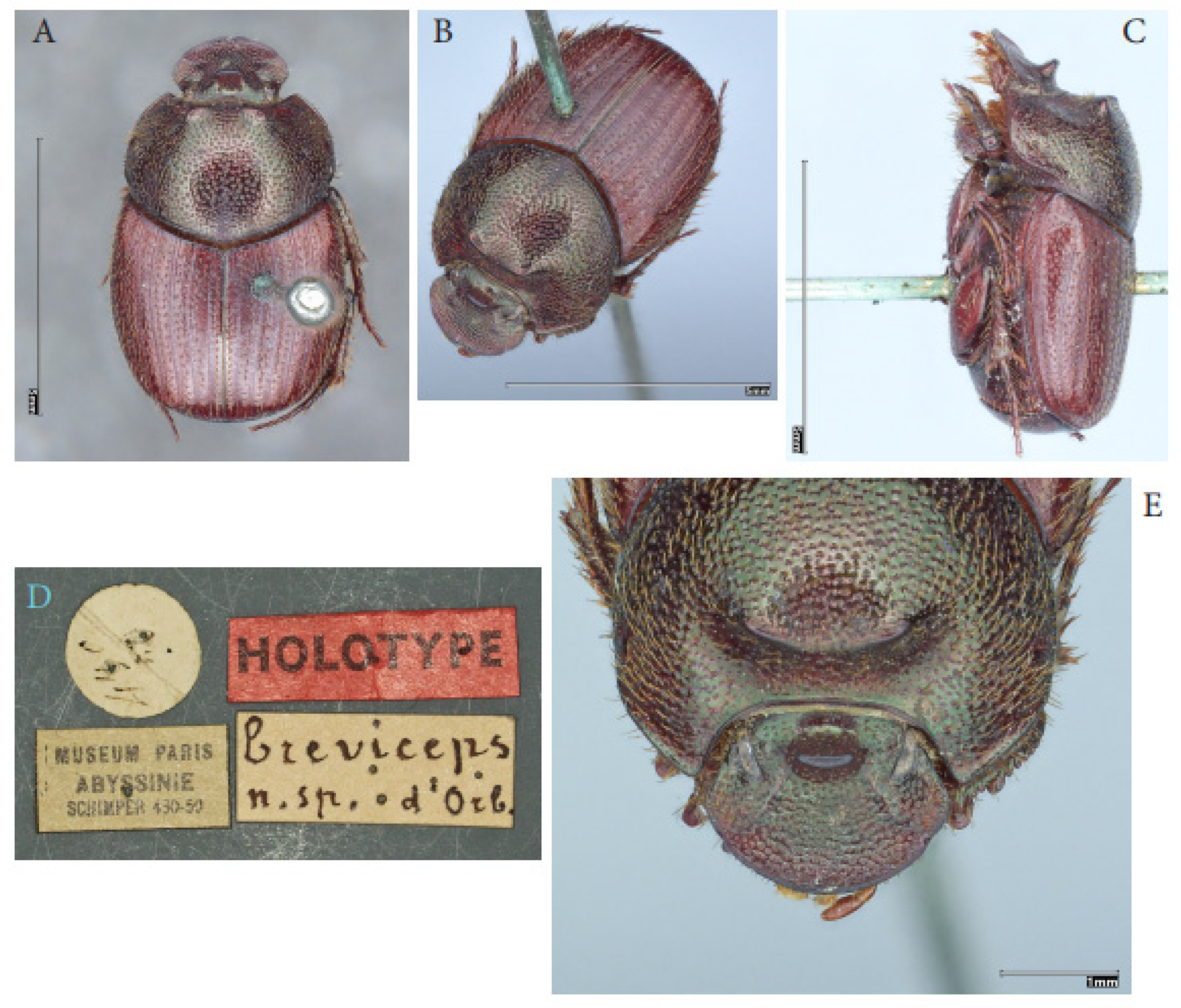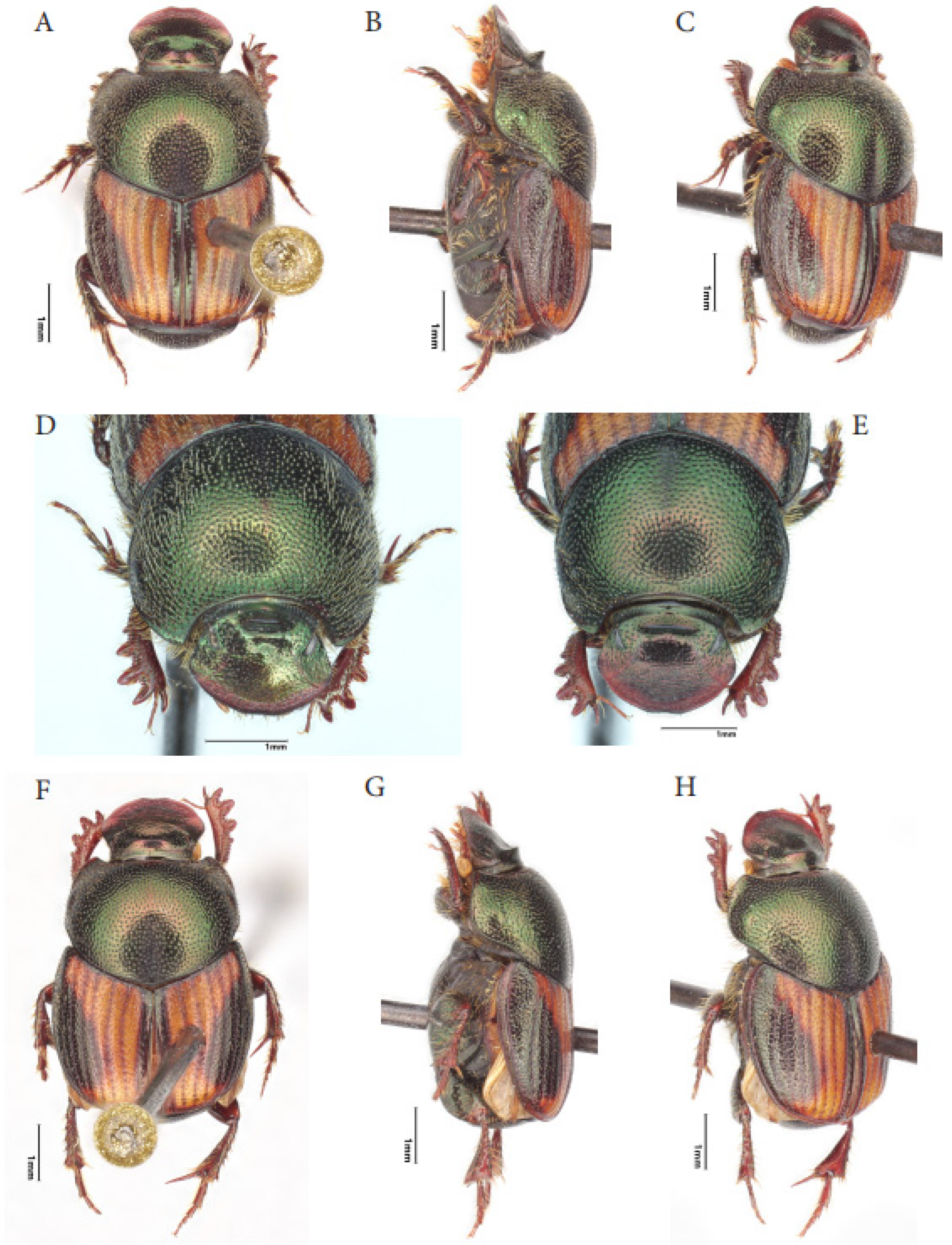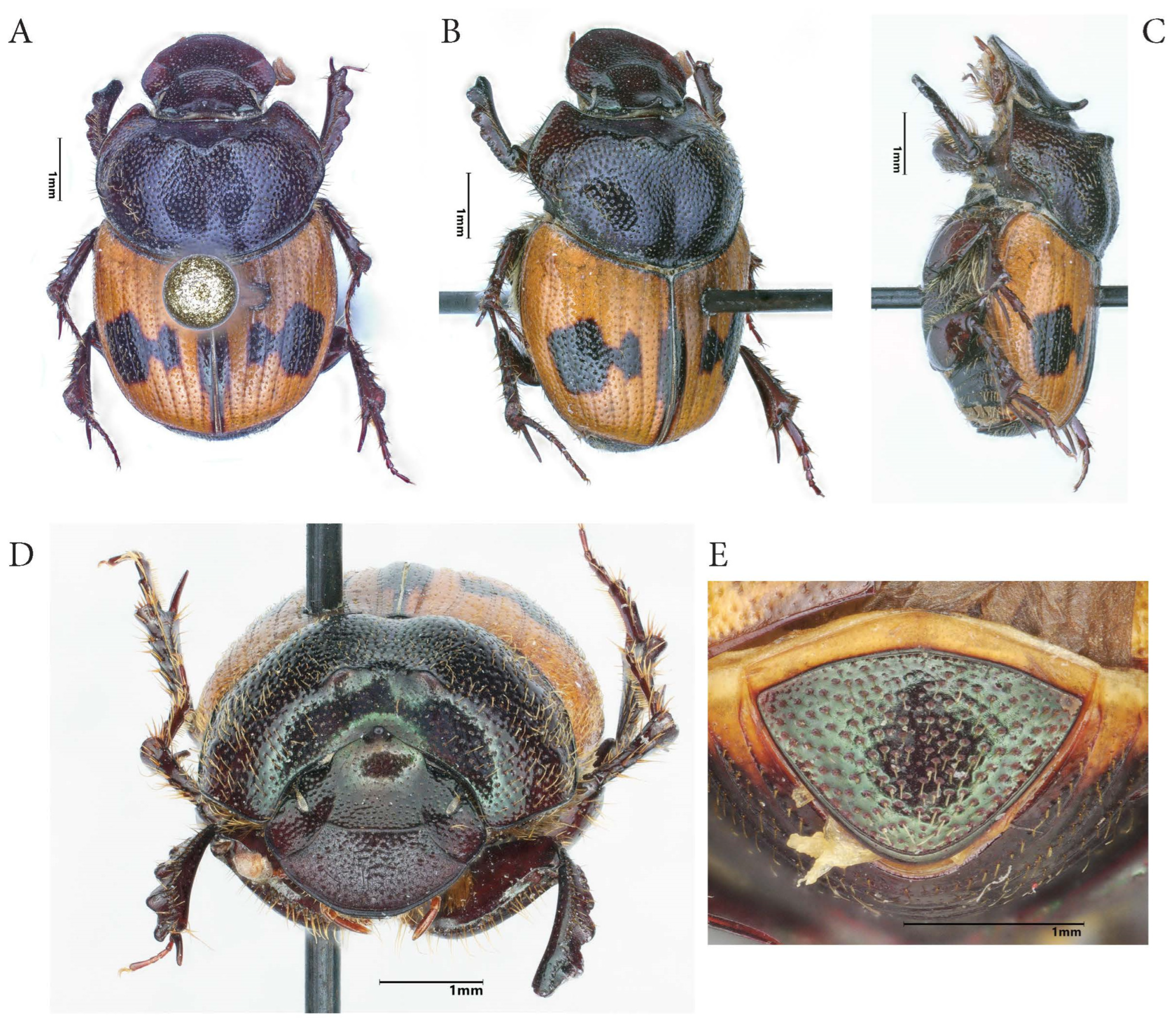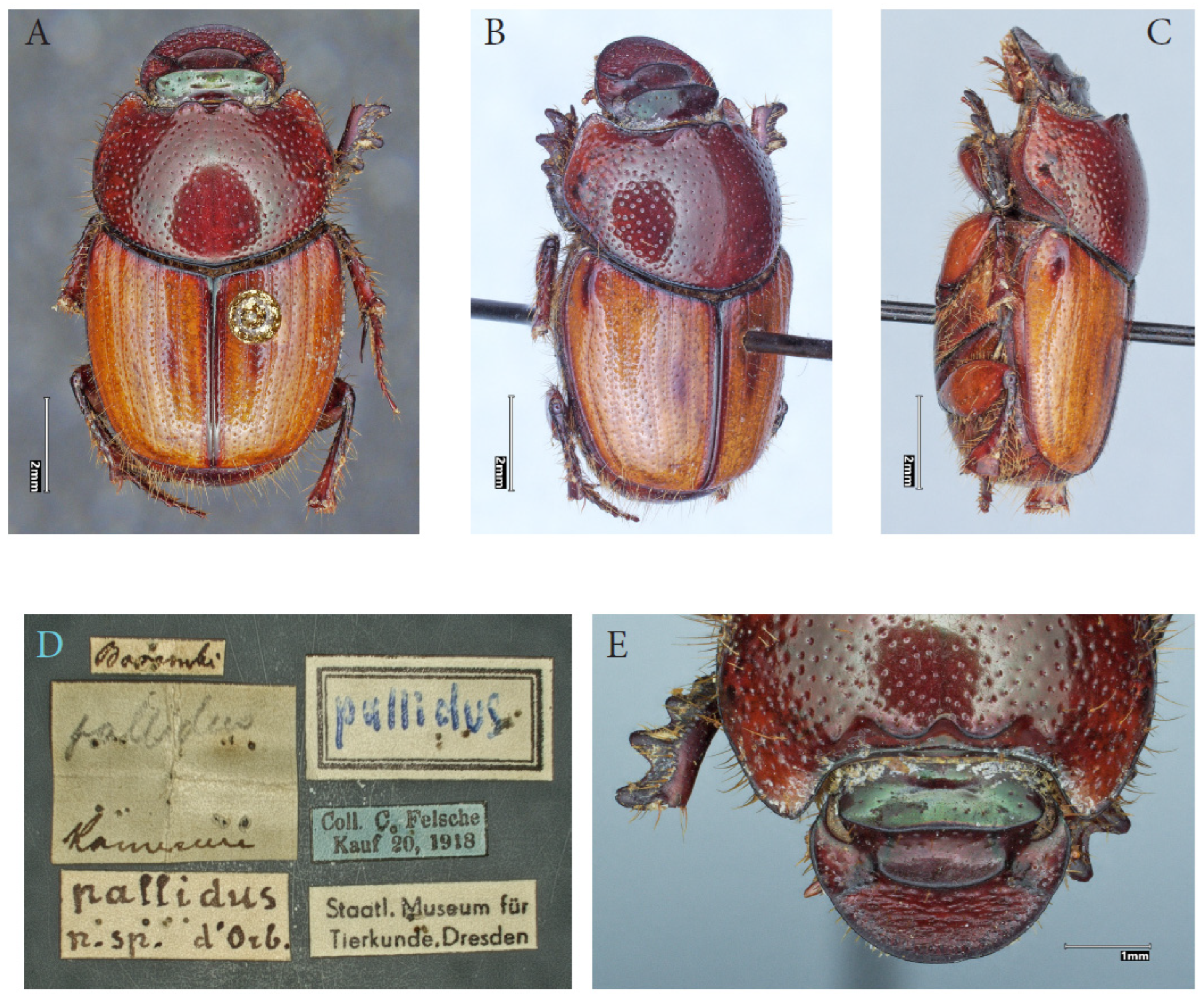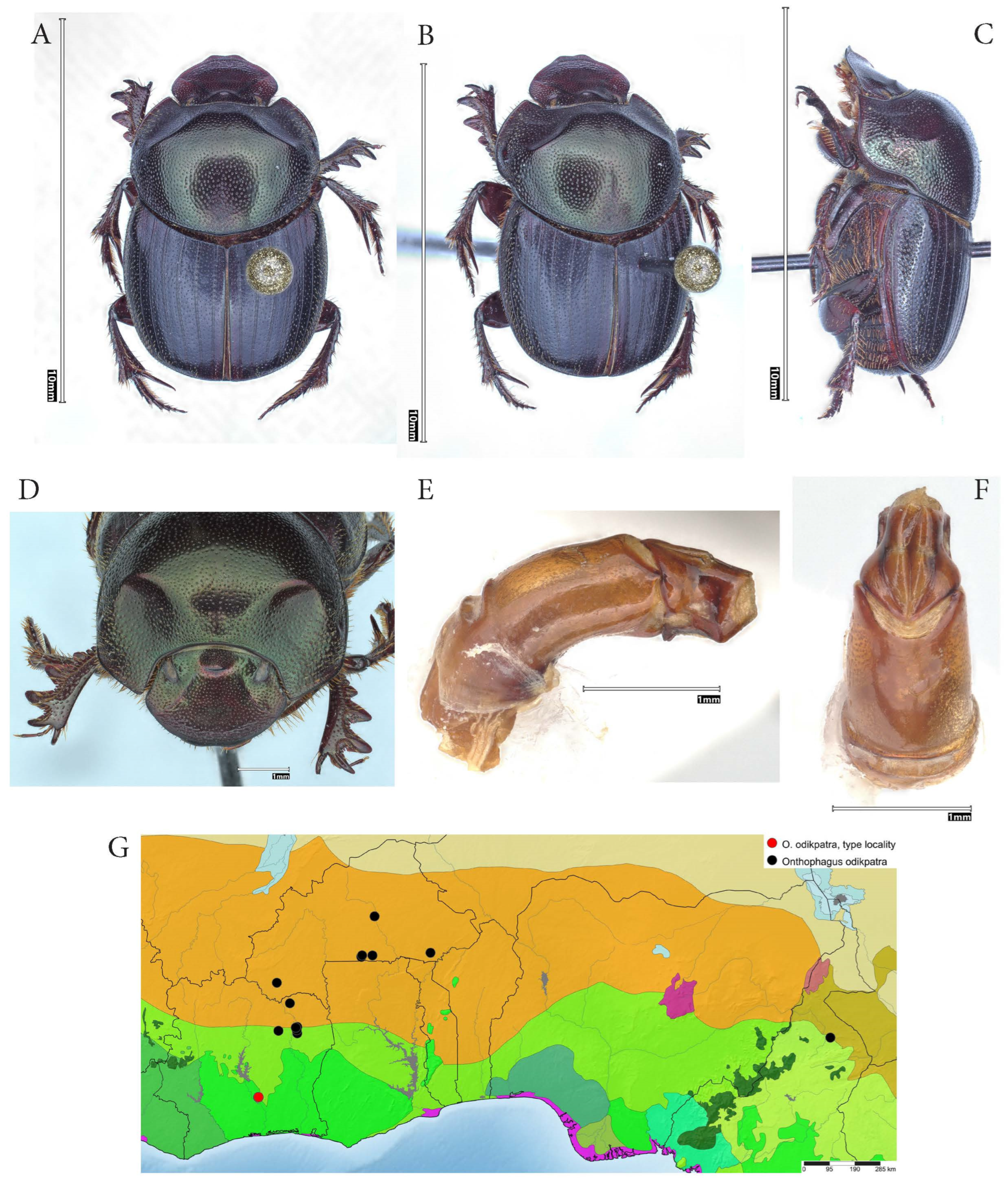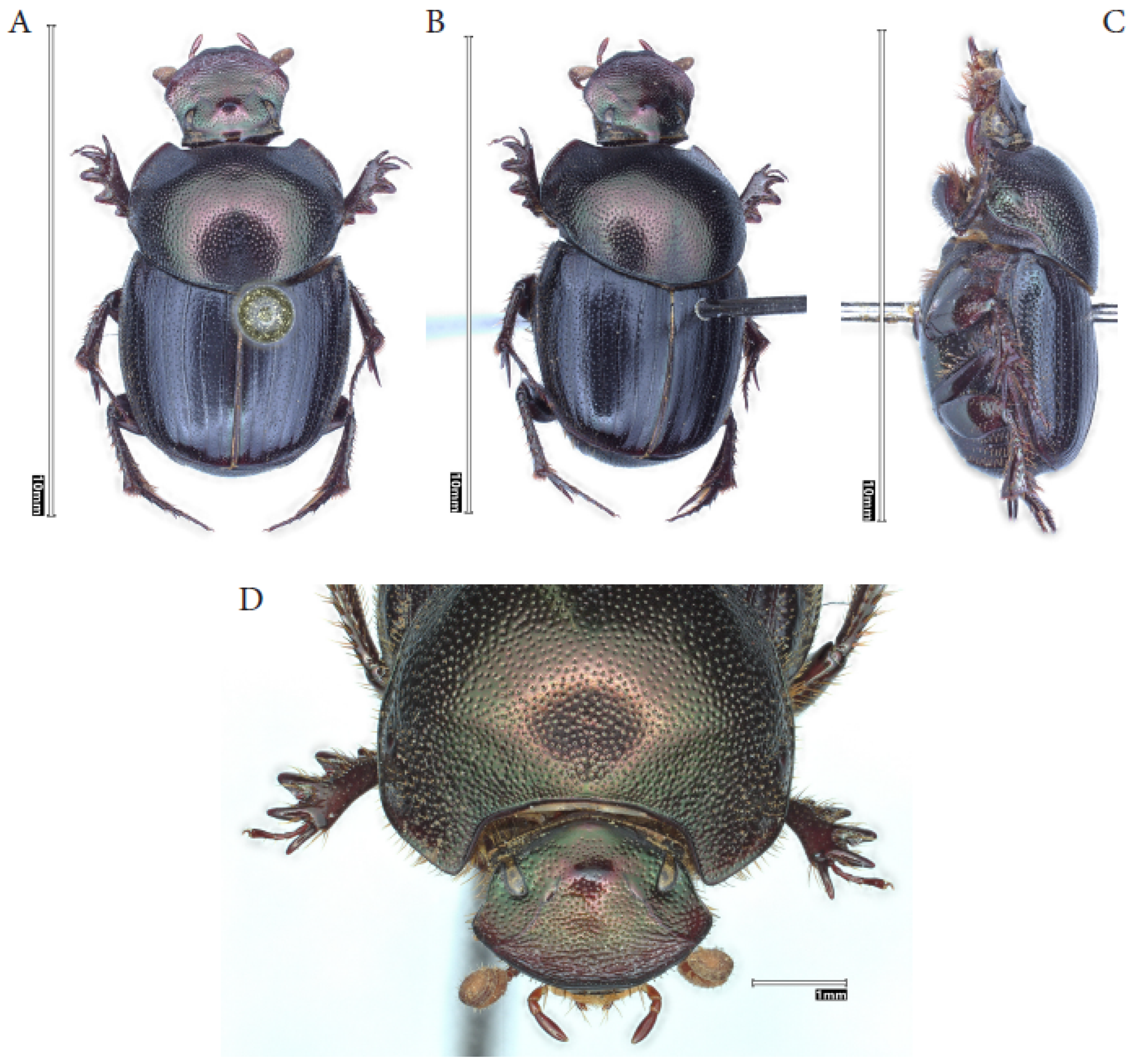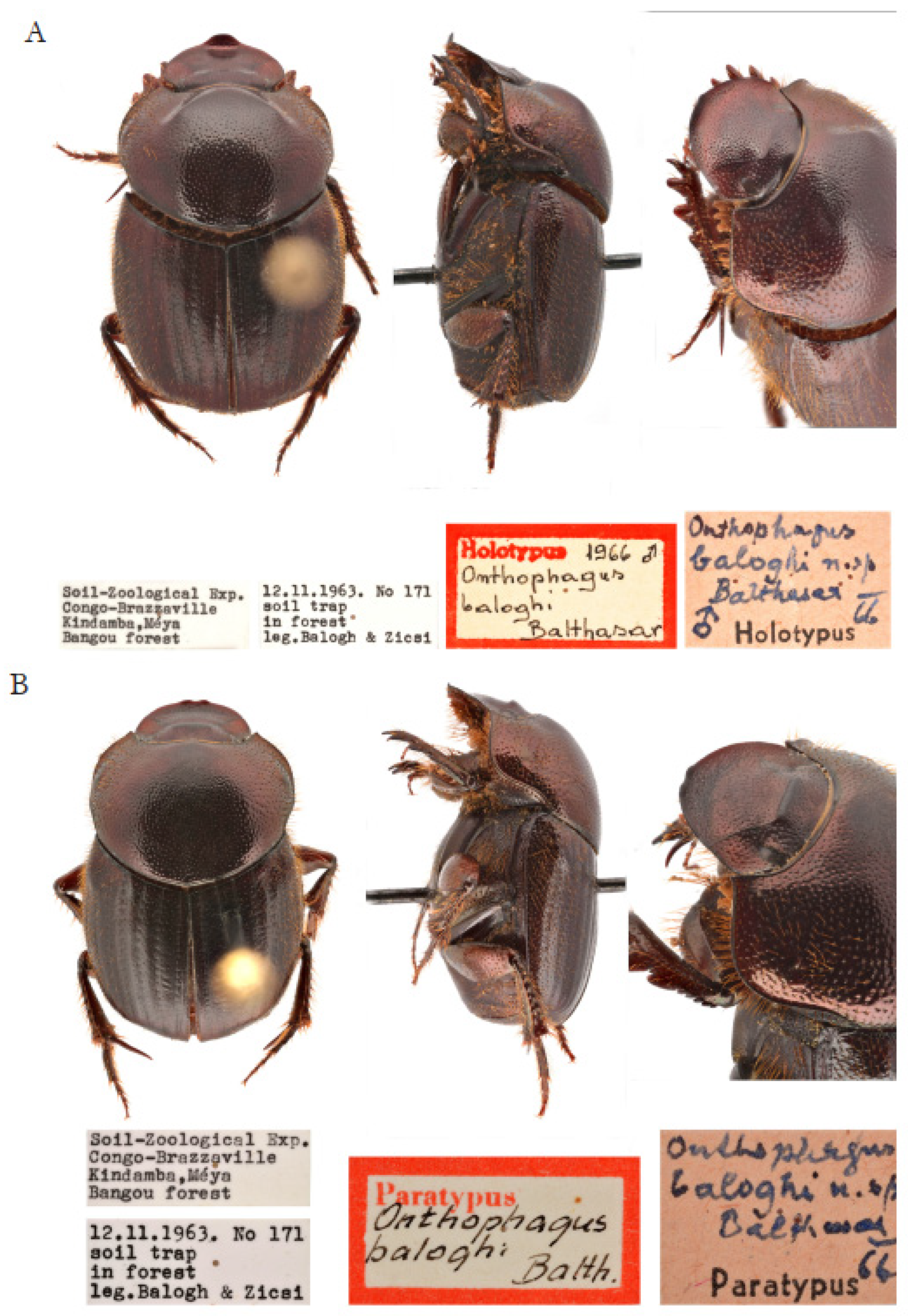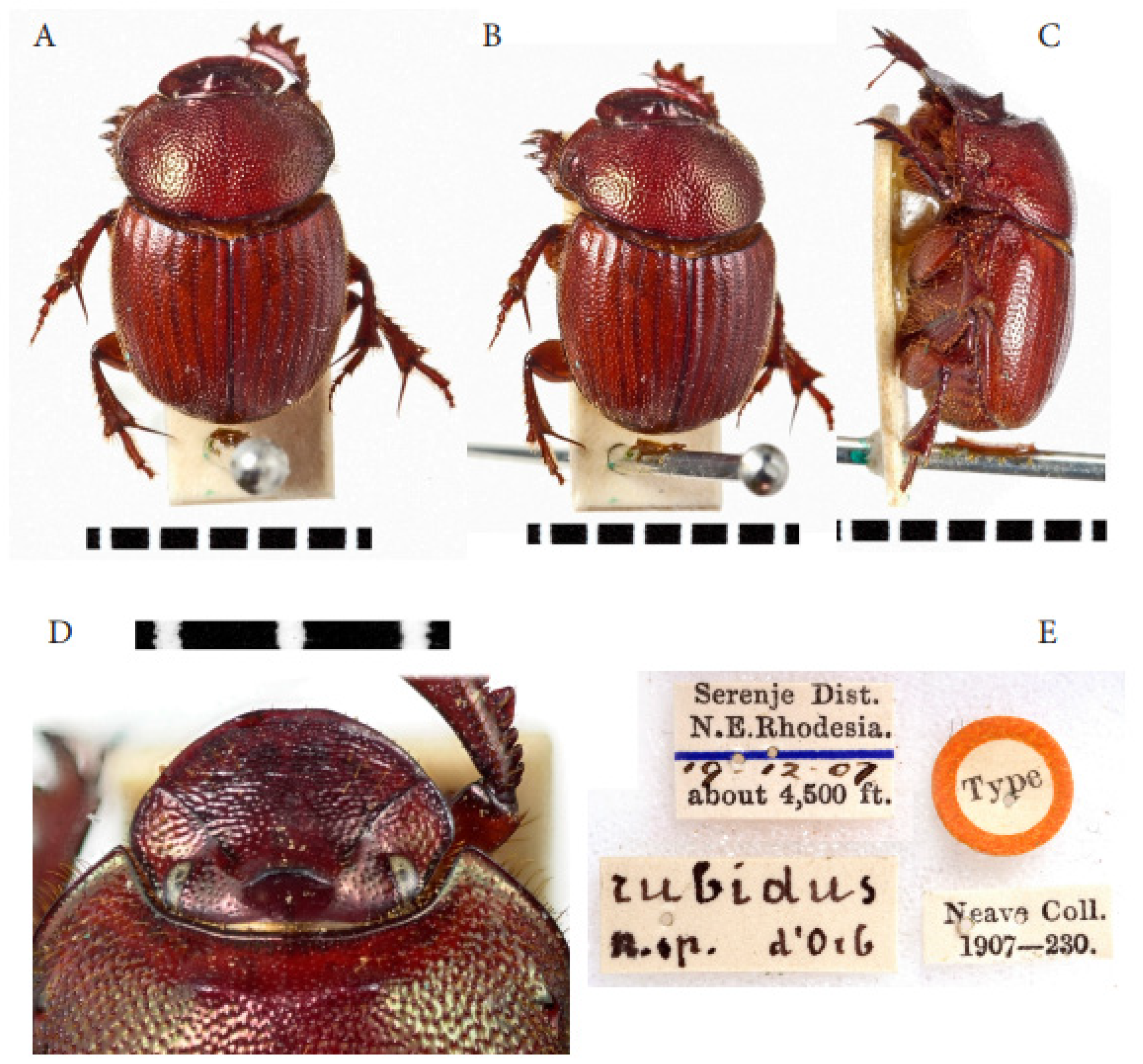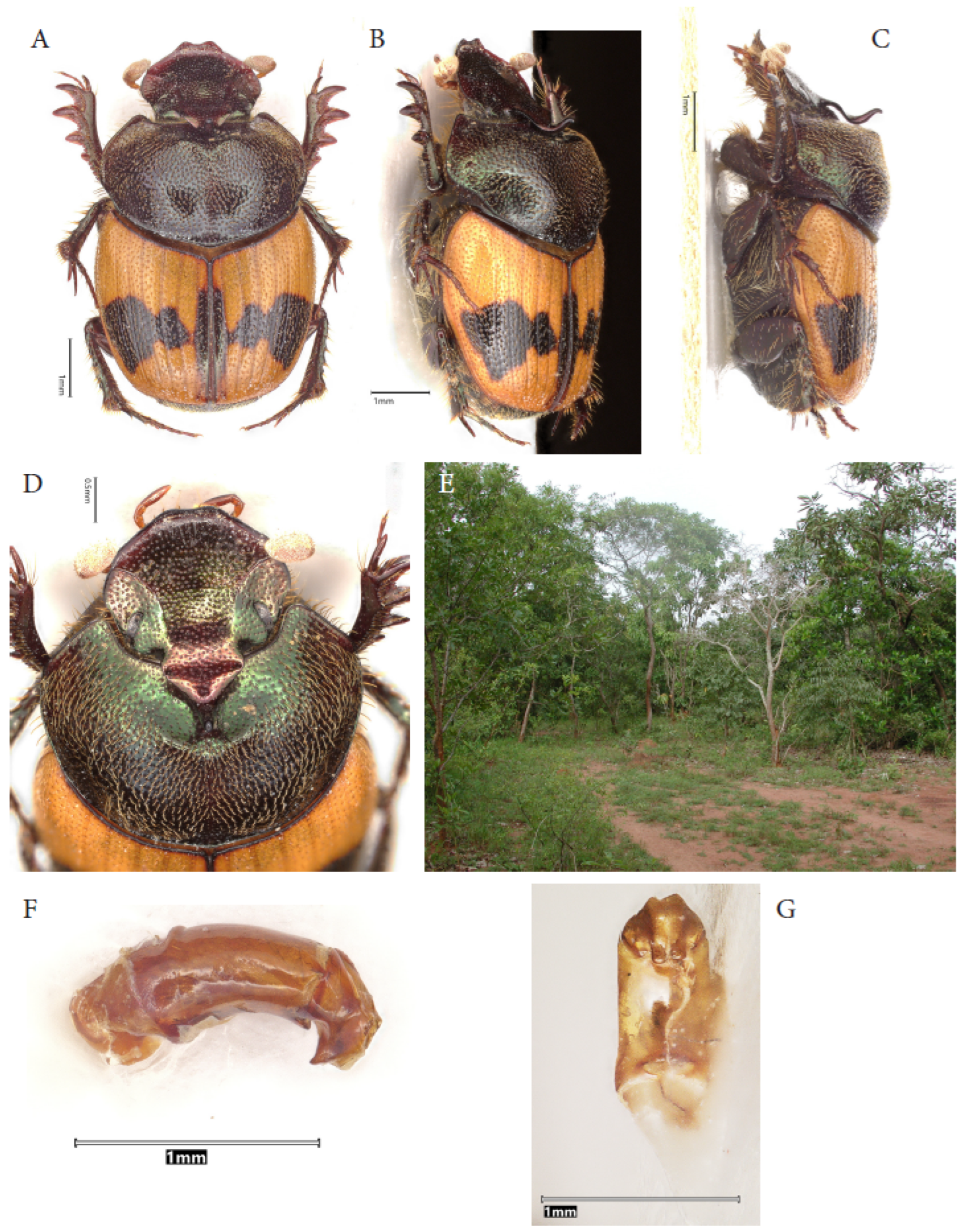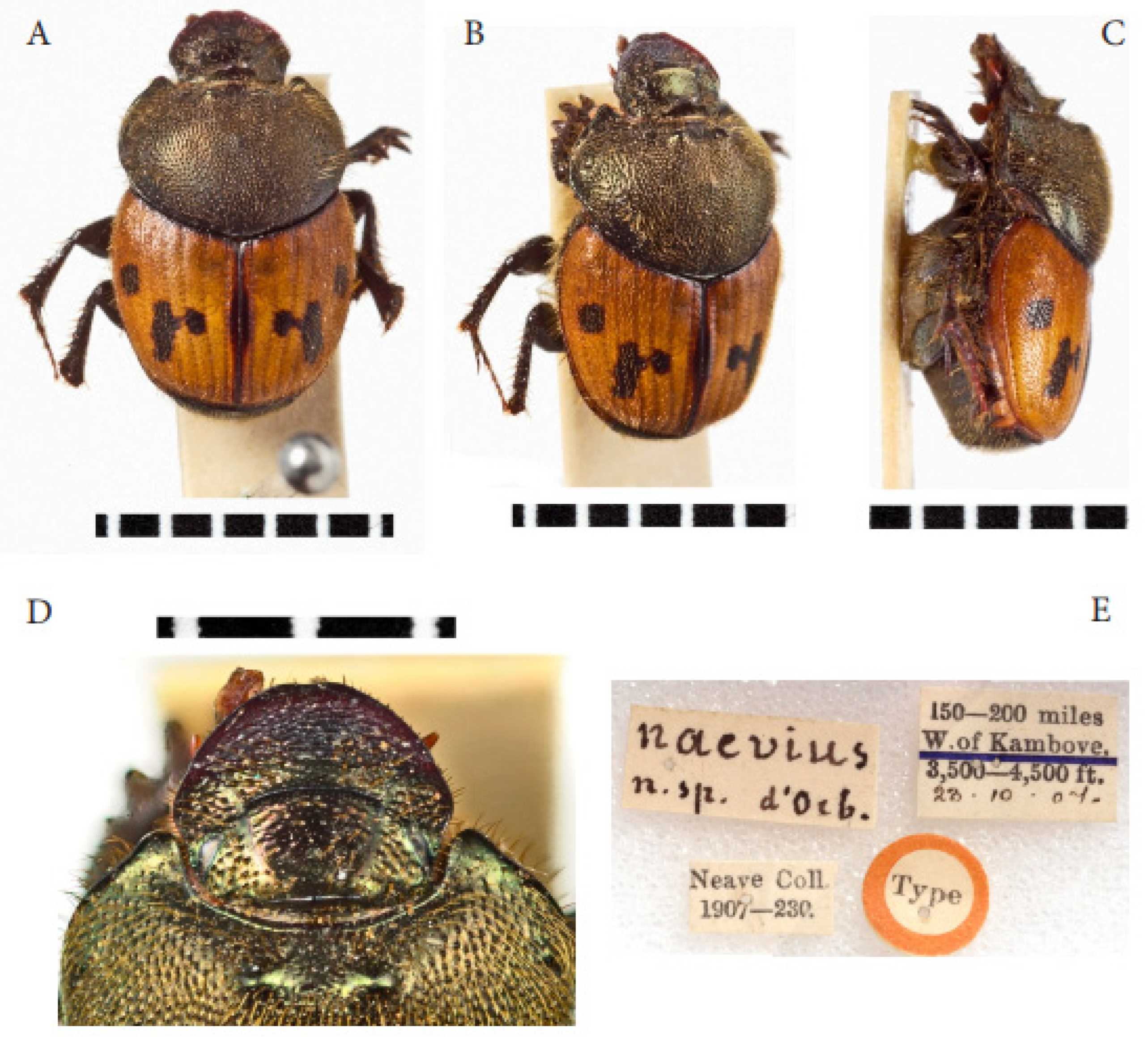3. Results (Species Descriptions)
12th group of d’Orbigny
Onthophagus (Trichonthophagus) sylviae Krell sp. nov.
Zoobank: urn:lsid:zoobank.org:act:9A60EC59-75FF-4DF1-ABD0-D65C6DCB5A96
Holotype (♂) (
Figure 1A–D): CÔTE D’IVOIRE,
Zanzan District: Parc National de la Comoé, near Lola Camp (former research camp of Würzburg University), savanna parkland (
Figure 2), in fresh cape buffalo dung (sample SC25 [
16]), 8°45′02″ N, 3°48′58″ W, elev. 192 m, 27.v.1997, 18–22 h, leg. Sylvia Westerwalbesloh, in the Natural History Museum, London, UK.
Paratypes (9 spm.): CÔTE D’IVOIRE,
Zanzan District: 1 ♀: Parc National de la Comoé, near Lola Camp (research camp of the University of Würzburg), savanna parkland, in fresh buffalo dung, 8°45′02″ N, 3°48′58″ W, elev. 192 m, 23.vi.1997, 18–22 h (SC76), leg. Sylvia Westerwalbesloh (DMNS). 1 ♀: dto., 09–10.vii.1997, 18–6 h (IC1), leg. Ingo Weiß (DMNS). 1 ♀: dto., 10–11.vii.1997, 18–6 h (IC6), leg. Ingo Weiß (DMNS) (
Figure 3A–E). 1 ♂, 1 ♀: dto., 22–23.vii.1997, 18–6 h (IC31), leg. Ingo Weiß (♂: DMNS; ♀: BMHN). 1 ♀: dto., 24–25.vii.1997, 18–6 h (IC34), leg. Ingo Weiß (DMNS). 1 ♀: Parc National de la Comoé, Lola Camp, gallery forest, in fresh cape buffalo dung, 8°45′10″ N, 3°48′57″ W, elev. 198 m, 20–21.vii.1997, 18–6 h (IC23), leg. Ingo Weiß (DMNS).
BURKINA FASO,
Nahouri Province: 2 ♂♂ [1 sequenced, no. DZTE 2]: Forêt de Nazinga, Akwazena, 11°09′24″ N, 01°36′44″ W, elev. 275 m, Sudan savanna, elephant dung and light trap, 26.vii.2006, leg. François & Simon Génier, 2006-76 (CFG) (
Figure 1E,F).
Etymology. The new species is dedicated to my wife Sylvia Krell-Westerwalbesloh who collected the first two specimens of the new species during field experiments for her diploma thesis [
16,
17].
Distribution (
Figure 3F). Northeastern Côte d’Ivoire, Comoé National Park and southern-central Burkina Faso, Nahouri Province.
Diagnosis. Trichonthophagus without notable sexual dimorphism in head and pronotal structures, keel-like carina on vertex without horn-like elevations, in large individuals with triangular, tooth-shaped elevations; bronze metallic, silky pronotum, regular punctures on elytra and pronotal disk, and orange-brown elytra, darkened only at suture and humeral callus.
Dimensions. Body length: 7.9–10.7 mm (holotype [HT]: 9.0 mm; arithmetic mean n = 10 = 9.3 mm; range of variation R = 2.8 mm = 30.1%). Maximum width of pronotum: 3.9–5.1 mm (HT: 4.3 mm; n = 10 = 4.5 mm; R = 1.2 mm = 26.7%). Maximum width of elytra: 4.2–5.4 mm (HT: 4.6 mm; n = 10 = 4.8 mm; R = 1.2 mm = 25.0%).
Color. Head and pronotum dark reddish-brown or black with dark to lighter bronze metallic sheen. Anterior angles of pronotum often (including holotype) slightly lighter. Elytra orange-brown with humeral callus; suture and sutural interstria darker but without cloudy darker area extending onto elytral disc in the middle of the elytra. Pygidium and ventral side dark brown; lateral parts of metasternum lighter to orange-brown. Femora orange-brown, other parts of legs dark brown.
Figure 1.
Onthophagus (Trichonthophagus) sylviae sp. nov. (A–D): Holotype ♂, Côte d’Ivoire, Parc National de la Comoé, Lola-Plaine, 27.v.1997, leg. Westerwalbesloh, BMNH: (A): dorsal; B: oblique dorsal; (C): lateral; (D): head and pronotum. (E,F): Paratype ♂, Burkina Faso, Nahouri, Forêt de Nazinga, 26.vii.2006, leg. F. & S. Génier, CFG (BF006966); (E): Aedeagus lateral; (F): Parameres dorsal (Photos: Frank-T. Krell).
Figure 1.
Onthophagus (Trichonthophagus) sylviae sp. nov. (A–D): Holotype ♂, Côte d’Ivoire, Parc National de la Comoé, Lola-Plaine, 27.v.1997, leg. Westerwalbesloh, BMNH: (A): dorsal; B: oblique dorsal; (C): lateral; (D): head and pronotum. (E,F): Paratype ♂, Burkina Faso, Nahouri, Forêt de Nazinga, 26.vii.2006, leg. F. & S. Génier, CFG (BF006966); (E): Aedeagus lateral; (F): Parameres dorsal (Photos: Frank-T. Krell).
Figure 2.
Lola Plaine near the Comoé gallery forest, Parc National de la Comoé, northeastern Côte d’Ivoire. Type locality for O. sylviae sp. nov. and O. chinonophilus sp. nov.; O. odikpatra and O. necnaevius sp. nov. also occur here (Photos: Sylvia Krell-Westerwalbesloh).
Figure 2.
Lola Plaine near the Comoé gallery forest, Parc National de la Comoé, northeastern Côte d’Ivoire. Type locality for O. sylviae sp. nov. and O. chinonophilus sp. nov.; O. odikpatra and O. necnaevius sp. nov. also occur here (Photos: Sylvia Krell-Westerwalbesloh).
Figure 3.
Onthophagus (Trichonthophagus) sylviae, sp. nov. (A–F): Paratype ♀, Côte d’Ivoire, Parc National de la Comoé, Lola-Plaine, 10–11.vii.1997, leg. Weiß, DMNS: (A): dorsal; (B): oblique dorsal; (C): lateral: (D): head and pronotum; (E): pronotal punctation (Photos: Frank-T. Krell). (F): Known localities for O. (T.) sylviae sp. nov., Côte d’Ivoire and surrounding countries.
Figure 3.
Onthophagus (Trichonthophagus) sylviae, sp. nov. (A–F): Paratype ♀, Côte d’Ivoire, Parc National de la Comoé, Lola-Plaine, 10–11.vii.1997, leg. Weiß, DMNS: (A): dorsal; (B): oblique dorsal; (C): lateral: (D): head and pronotum; (E): pronotal punctation (Photos: Frank-T. Krell). (F): Known localities for O. (T.) sylviae sp. nov., Côte d’Ivoire and surrounding countries.
Microsculpture. Distinct reticulate microsculpture everywhere apart from shiny legs. Pronotum and elytra dull or silky (
Figure 1D and
Figure 2D–E); head and ventral side slightly shinier.
Head. Almost semicircular with broadly rounded genae, not separated from clypeus, but protruding from the eyes. Frontal carina positioned anterior of eyes, keel-shaped, curved with ends directing caudally, and of equal height for the full length; half as long as width of head. Carina on vertex longer, almost as long as width of head behind eyes, curved with ends directed caudally, but with a caudal bend in the middle so that it has the shape of a very shallow, rounded, upside-down W; in frontal view, emarginate on both sides, with lateral ends forming right angles. Shape of carinae similar in both sexes. Clypeus strongly transversely wrinkled. Between carinae shiny and smooth, with sparse microscopic punctures, with some regular punctures and setae only on anterior declivity of posterior carina. Posterior side of posterior carina with transversal row of punctures, sometimes interrupted in the middle (continuous in holotype), and additional punctures laterally. Punctures and wrinkles bear erect brown setae.
Antennae. Brown. Clavus of regular shape, without cupuliform antennomeres.
Pronotum. Front angles angulate to slightly rounded, margin behind front angles straight to slightly emarginate. Hind angles broadly rounded, and sides in front of hind angles emarginate. Basis in the middle with very broad, indistinct angle. With short, vertical declivity in front, of about half the width of pronotum, generally smooth, but with sparse microscopic and a few larger punctures and setae. Behind declivity with two forward and slightly upward-directed touching lobes, lateral of them, separated by curved indentation, with upward-directed denticle. In smaller individuals, declivity low and denticles reduced to a double-S-shaped carina. Punctation simple on disc, distance between punctures larger than their diameter (
Figure 3E); laterally increasingly rasp-like and dense; near lateral margins granulose, with distance between granules larger than their diameter. Punctures with erect brown setae. Narrow, median longitudinal strip on pronotal disc smooth and not elevated, only in front and basally, with few punctures. In the middle of pronotal sides, with smooth bump and small smooth area lateral and caudal to it. Basis finely margined; margin reduced on both sides of the middle. Without depressions or differently punctured or microsculptured areas near posterior angles.
Protibiae. With four external denticles preceded by two small basal denticles. Apical spurs in both sexes similar, flattened, spatulate, slightly curved downward, parallel-sided with short tips, almost reaching apex of fourth tarsomere.
Elytra. Narrow striae with indistinct punctures slightly denting interstriae. Interstriae with large regular (not rasp-like) punctures bearing orange setae, in 2nd to 6th interstriae arranged in two irregular rows, in sutural interstria as one row, in lateral interstriae irregular. Punctures lateral of humeral callus slightly rasp-like.
Pygidium. With dense, regular punctures of irregular size and long and shorter setae. Punctures less dense basally. Transverse strip at basis smooth.
Aedeagus (
Figure 1E,F). Parameres short, in dorsal view of triangular shape, ending in a little ventral denticle that is visible dorsally as it protrudes laterally; dorsally and apically with short membranous appendix.
Phenology. The specimens were found from May to July with the highest number in July. We collected in the Parc National de la Comoé repeatedly from March to August and December to January but did not find the species in any other months.
Ecology. All specimens from Côte d’Ivoire were found in fresh Cape buffalo dung (Syncerus caffer) that was exposed overnight. Seven specimens were found in the savanna parkland, about 150 m from the Comoé gallery forest; one specimen was found inside the gallery forest, around 20 m from its edge, but under the canopy. The specimens from Burkina Faso were also found in savanna parkland, one in elephant dung and one at light. The small number of specimens found does not allow us to draw robust conclusions, but the species seems to prefer an open habitat. The species is crepuscular or nocturnal and positively phototactic.
COI Barcode DNA Sequence.
Classification. The subgenus
Trichonthophagus Zunino, 1979 [
18], created for two European species, forms part of d’Orbigny’s [
7] 12th group. Palestrini [
19] subsumed 11 species, but the recent list of Moretto [
12] includes 33 to 35 species, to which we now need to add
O. (T.) sylviae sp. nov.
Identification. Using the key for the 12th group of
Onthophagus in d’Orbigny’s Synopsis [
7] (pp. 220–240) leads to
Onthophagus pallidus d’Orbigny, described from a single female from [Lake] Barombi in southwestern Cameroon [
20]. The female holotype of
O. pallidus (
Figure 4), preserved in SMTD, is compared to
O. sylviae in
Table 1.
18th group of d’Orbigny
Onthophagus odikpatra Krell sp. nov.
Zoobank: urn:lsid:zoobank.org:act:47A0A59F-E882-4D28-A71F-6EB2E759E135
Holotype (♂;
Figure 5A–D): CÔTE D’IVOIRE,
Les Lacs District: Bringakro, savanna, 6°25′07.1″ N, 5°04′01.0″ W, pitfall traps with fish, 19.vii.2004, sample BRX10, leg. Frank-T. Krell; in the Natural History Museum, London, UK.
Paratypes: CÔTE D’IVOIRE,
Vallée du Bandama District: 26 ♂♂, 24 ♀♀: north of Dabakala, Ouandérama, ca. 8°38′35″ N, 4°24′01″ W, elev. 242 m, grazed savanna parkland, 26–27.v.2016, fresh millipede trap [in one male, we found a CO1 sequence of 95.4% similarity to that of a specimen of
Pelmatojulus tigrinus Hoffman & Mahsberg, 1996 [
21] (Spirobolida: Pachybolidae) from Parc National de la Comoé, ca. 80 km ENE of Ouandérama [
22], indicating that the millipede Moretto used for trapping belonged to that or a closely related species], 2016-123, leg. Philippe Moretto (PMOC); 3 ♂♂ dto., 24–29.v.2016, 2016-129 (PMOC); 10 ♂♂, 2 ♀♀: dto., 2016-120 (PMOC). –
Zanzan District: 1 ♀: Parc National de la Comoé, Ouango Fitini [ca. 9°35′ N, 4°01′ W], 05.v.1981, millipede carcass, leg. Yves Cambefort, P-680 (MNHN).—4 ♂♂, 6 ♀♀ (DC327); 2 ♂♂ (DC417): Parc National de la Comoé, savanna parkland south of Kongo, 8°46′20″ N, 3°45′58″ W, 11.vi.1997, pitfall trap baited with freshly dead millipede
Pelmatojulus tigrinus), leg. Thomas Schmitt; 1 ♂, 1 ♀: dto., 18.vii.1997, DC422 (DMNS).—1 ♂: PN Comoé, Upper Bretelle near Lola Camp, savanna parkland, 8°45′09″ N, 3°48′54″ W, 30.vi.1995, mercury light, 18:40–21:00 h, L216, leg. Frank-T. Krell (DMNS).—2 ♀♀: PN Comoé, track at Lola Camp, 8°45′05″ N, 3°48′59″ W, 29.vi.1995, millipede carcass, BB and BE, leg. Franziska Krämer; 1 ♀: dto., 12.vii.1995, DZ; 1 ♀: dto., 13.vii.1995, EG; 3 ♀♀: dto., 14.vii.1995, EP (2), EQ (1) (DMNS).—7 ♂♂: PN Comoé, Plaine de Lola, savanna parkland (
Figure 2), 8°45′02″ N, 3°48′58″ W, 01.vi.1997, pitfall trap baited dead
Pelmatojulus tigrinus, DC228 (5), DC229 (2), leg. Thomas Schmitt; 1 ♂: dto., 04.vi.1997, DC269; 1 ♂: 09.vi.1997, DC315; 1 ♀: 01.viii.1997; 1 ♀: 23.iv.1998, W48, leg. Thomas Schmitt & Gudrun Herzner; 1 ♀: 25.iv.1998, W71, leg. Thomas Schmitt & Gudrun Herzner (DMNS) (
Figure 6).—2 ♂♂: Parc National de la Comoé, gallery forest at Lola Camp, 8°45.2′ N, 3°49.0′ W, elev. 195 m, 08.iv.1996, 19 h, dead
Pelmatojulus tigrinus, LB166, leg. Frank-T. Krell (DMNS).—1 ♂: Parc National de la Comoé, savanna parkland near Lola-Camp, 8°45′04″ N, 3°48′58″ W, elev. 195 m, 23.vii.1997, 23:25 h, goat skin ST4, Z1129, leg. Minnattallah Boutros (DMNS).—37 ♂♂, 30 ♀♀: Parc National de la Comoé, Comoé 2, 8°40′03.1″ N, 3°47′03.1″ W, millipede baited pitfall trap, 28.vi.–02.vii.2015, leg. Marios Aristophanous, Philippe Moretto & Enrico Ruzzier (BMNH) (
Figure 5E,F).—1 ♂: Parc National de la Comoé, 12.xi.1978, leg. Bordat (MNHN).—1 ♂: [Parc National de la] Comoé, 2001, leg. Philippe Moretto (PMOC).—1 ♀: Zamou [ca. 8°33.5′ N, 3°46′ W], viii–ix.1996, leg. Philippe Moretto (PMOC); 4 ♂♂, 8 ♀♀: dto., viii.1997; 1 ♂, 1 ♀: dto., iv.1998; 3 ♂♂: dto., viii.–ix.1998; 4 ♂♂, 1 ♀: dto., xi.1998; 3 ♂♂: 07–12.vi.2000; 3 ♂♂, 11 ♀♀: dto., viii.2000; 1 ♀: dto., v.2001; 1 ♂: dto., iv.2002; 1 ♂: dto., iv.2004 (all PMOC).—
Les Lacs District: Bringakro, savanna, 6°25′07.1″ N, 5°04′01.0″ W, pitfall traps with fish, leg. Frank-T. Krell, 18.vii.2004 (2 ♂♂, 2 ♀♀ BRX7; 7 ♂♂, 5 ♀♀ BRX8), 19.vii.2004 (5 ♂♂, 5 ♀♀ BRX9; 8 ♂♂, 9 ♀♀ BRX10), 20.vii.2004, 3 days old fish (1 ♂, 3 ♀♀ BRX12), 21.vii.2004 (2 ♂♂, 3 ♀♀ BRX18, 4 days old fish; 5 ♂♂, 3 ♀♀ BRX19) (DMNS; 2 pairs BRX10: BNMH; 2 pairs BRX9: ZFMK).—5 ♂♂,3 ♀♀: Bringakro, savanna near lake, 6°25′23.1″ N, 5°05′14.7″ W, alt. 138 m; pitfall traps with meat, 20.vii.2004, BRX14, leg. Frank-T. Krell (DMNS; 2 pairs: ZFMK); 2 ♂♂, 1 ♀: dto., 21.vii.2004, BRX20 (DMNS).—3 ♂♂: Bringakro, savanna, cattle exclosure site near CSRS experimental fields, 6°25′52″ N, 5°04′31″ W, elev. 130 m, human dung traps 24–26.iv.2002, leg. Frank-T. Krell (BKFII-2 (2), BKFII-5 (1; sequenced, no. DZTE 31) (DMNS).
BURKINA FASO, Kadiogo Province: 1 ♂, 1 ♀: Pabré, 12°30′ N, 1°10′ W, x.1970, leg. Père Fernandez (PMOC).—Nahouri Province: 3 ♂♂, 2 ♀♀: Forêt de Nazinga, Akwazena, zone soudanienne, savane boisée, 11°09′24″ N, 01°36′44″ W, 275 m, piège lumineux, 21.vii.2006, leg. François & Simon Génier, 2006-53, BF013757, BF013758, BF013759, BF013760, or BF013761 (CFG); 1 ♂, 1 ♀: dto., 26.vii.2006, 2006-76, BF013764 or BF13765 (CFG); 1 ♀: dto., 23–27.vii.2006, general collecting, 2006-80, BF013766 (CFG).—1 ♀: Forêt de Nazinga, Barka, Sudan zone, savanna parkland, 11°08′30″ N, 1°36′35″ W, elev. 265 m, flight intercept trap, 23.vii.2006, leg. François & Simon Génier, 2006-59, BF013762 (CFG); 1 ♀: dto., light trap, 24.vii.2006, 2006-62, BF005994 (CFG).—1 ♂: Forêt de Nazinga, Naguio, Sudan zone, savanna parkland, 11°08′30″ N, 01°36′35″ W, elev. 270 m, light trap, 24.vii.2006, leg. François & Simon Génier, 2006-66, BF013763 (CFG).—1 ♂: Forêt de Nazinga, Boulieselo, Sudan zone, savanna parkland, 11°11′50″ N, 01°35′09″ W, elev. 310 m, light trap, 27.vii.2006, leg. François & Simon Génier, 2006-82, BF013767 (CFG).—Centre Sud Province: 1 ♂: Tiakané, south Sudan zone, 11°11′37″ N, 1°14′10″ W, elev. 320 m, light trap, 20.viii.2005, leg. François Génier, 2005-29, 02956 (CFG); 1 ♀: dto., 02957 (CFG); 1 ♂: dto., on dead earthworm, 2005-33 (CFG). Comoé Province: 4 ♂♂: Koflandé (village), tree savanna (Sudan zone), 10°14′42″ N, 04°27′50″ W, elev. 290 m, light trap, 04.vii.2006, leg. François & Simon Génier, 2006-01, BF013752, BF013753, BF013754, or BF013755 (CFG).—1 ♀: Forêt de Boulon, Sudan zone, savanna parkland, 10°16′27″ N, 04°27′15″ W, elev. 270 m, carrion trap, 09.vii.2006, leg. François & Simon Génier, 2006-22, BF013756 (CFG).—Kompienga Province: 1 ♂: Pama, 11°17′00″ N, 0°42′59″ E, elev. 230 m, 25–28.viii.2005, leg. François Génier, south Sudan zone, flight intercept trap, 2005-48 (PMOC); 3 ♂♂: dto., 24.viii.2005, light trap, 2005-44 (PMOC); 5 ♂♂: dto., 24–28.viii.2005, light trap, leg. Philippe Moretto (PMOC).
CAMEROON, North Region: 1 ♂: Tcholliré [ca. 8°25′ N, 14°10′ E]. vii.1989, leg. Dominique Bernaud (PMOC).
Etymology. Ɔ di kpatra (Baoulé) = “He eats fish” [
23]. Actually, he also eats dead millipedes, deceased earthworms and goat carrion, and human dung, but this does not need to be elaborated in his name.
Distribution (
Figure 5G). Guinea and Sudan savanna of central and northeastern Côte d’Ivoire, southern and central Burkina Faso, and northern Cameroon. The latter record indicates the possibility that this species might be found in the Sudan/Guinea savanna belt between Burkina Faso and Cameroon.
Diagnosis.
Onthophagus of d’Orbigny’s [
7] group 18, black, with dark-bronze sheen on pronotum and head; pronotum between lateral impressions not elevated; sides of pronotum with simple punctures (only above the middle of lateral margin rasp-like), pygidium with dense regular oval punctures.
Dimensions. Body length: 6.8–10.4 mm (HT: 8.5 mm; n = 40 = 8.5 mm; range of variation R = 3.6 mm = 42.3%). Maximum width of pronotum: 3.5–5.4 mm (HT. 4.9 mm; n = 40 = 4.6 mm; R = 1.9 mm = 41.3%). Maximum width of elytra: 4.2–5.8 mm (HT: 5.4 mm; n = 40 = 5.0 mm; R = 1.6 mm = 32.0%).
Color. Black, pronotum and head with weak dark-bronze metallic sheen. Elytra without metallic sheen, but often very dark reddish (holotype: black). Underside with faint or no metallic sheen. Pygidium black.
Microsculpture. Dorsally shiny to silky. Distinct reticulate microsculpture on elytra. Microsculpture of pronotum rather shagreened with microscopic punctures between punctures. Ventrally shinier, with reticulate to shagreened microsculpture.
Head. Trapezoid, genae rounded, not separate from clypeus, but protruding from eyes. Sides of clypeus rounded; apex with two short, rounded lobes curved upward, slightly emarginate between lobes. Without frontal carina. Carina of vertex short, just over half the width of distance between eyes, forming a rather flat to erected lobe in the shape of a flat-parabolic curve; on its posterior slope densely covered by small punctures; on its anterior slope densely covered by larger punctures. Lobe higher in females. Punctures in males smaller than in females. In males, only a small strip is wrinkled, with wrinkles occupying anterior quarter of the distance between vertical carina and front margin, whereas in females, wrinkles extend over anterior half. Dorsal surface of head bald with rare remnants of tiny setae on sides.
Antennae. Dark brown with clavus orange to orange-brown. Clavomeres curved, ventral side of clavus flattened, apical clavomere flat (holotype) to concave at the end. Clavomeres densely covered with short, light, flat-lying setae, interspersed with sparse long erect setae.
Pronotum. Front angles rectangular, margin behind front angles slightly rounded to almost straight. Hind angles barely marked and broadly rounded, sides in front of hind angles emarginate. Basis margined, with obtuse angle in the middle. Pronotal punctures simple to distinctly ocellate, dense with distance between punctures less than their diameter, stronger on sides than on disk, only above the middle of lateral margin rasp-like and uneven. Pronotal basis without depression on each side or with very shallow transversal depression (holotype), punctures slightly denser, sometimes touching, and shallower, therefore more ocellate than punctures in surrounding areas. Disk in basal half with shallow longitudinal furrow. Pronotum with short, half-erect, light setae, particularly on sides. Sexual dimorphism: In large males (including holotype), anterior half with two concave declivities on each side, bordered by a curved bulge at the top and small flat depression in front between those declivities; punctures in large declivities smaller than on sides or disc of pronotum, becoming smaller and sparser toward upper bulge. Large females with slightly impressed and much smaller declivity on each side; declivities strongly and densely punctured. Pronotal punctures stronger in females than in males.
Protibiae. With four external denticles, preceded and interspersed by accessory denticles. Apical denticle thinner and shorter than penultimate one. Apical spur curved downward, almost reaching fifth tarsomere (male) or reaching middle of fifth tarsomere. With sharp tip in females and cut-off tip in males.
Elytra. Narrow striae with flat punctures slightly denting interstriae. Interstriae on disk with irregular small simple punctures; punctures larger toward sides. Punctures in the two lateral interstriae coarser and rasp-like. Sides and apex with short, light, half-erect setae.
Pygidium. With dense, regular, oval punctures of irregular size and light, short, half-erect setae. Propygidium densely, finely punctured and dull.
Aedeagus (
Figure 5E,F). Parameres short, apically parallel, ending ventro-apically in a blunt right angle, without laterally protruding denticles, with short apical membranous appendix. Parameres on ventral basis with triangular denticles.
Phenology. April to August (rainy season).
Ecology. The 18th group of d’Orbigny [
7] contains several species commonly found on freshly dead millipedes.
O. odikpatra is attracted to this resource, but is more generalist, being also found on rotting fish, dead earthworms, goat carrion, and human dung. It is positively phototactic and occurs in the open grasslands or savanna parklands of the Guinea and Sudan savanna.
COI Barcode DNA Sequence.
Classification. The pronotum being impressed on both sides anteriorly with mainly simple punctation, marginated base, and rasp-like punctures near the lateral margins places this species in the 18th group of d’Orbigny [
7].
Identification. Using the key of d’Orbigny [
7] (pp. 320ff) for the 18th group, the new species would key out at 17 (16) and is most similar to
Onthophagus baloghi Balthasar, 1967 [
24] (
Figure 7). With
O. baloghi, O. odikpatra, and
O. chinonophilus (see below) added, the key would read as follows:
| page 325: |
| 17. (16). Vertex with tubercle or transverse keel or lobe................................................18a |
18a. (19a). Prothorax in the middle, between lateral depressions, forms a hump, the
elevated sides of which form an elevated tubercle. Vertex with fine interrupted carina
(O. epilamprus from western-central Africa) or with tubercle (O. croesulus from South
Africa).........................................................................................continue in d’Orbigny’s [7] |
| key at no. 18 (19) (p. 325) (O. croesulus Bates, O. epilamprus Bates) |
19a. (18a). The sides of prothoracic elevation between lateral impressions are not
elevated or dorsal margins of lateral impressions are not well indicated. Vertex with
short carina.........................................................................................................................20a |
20a. (21a). Pygidium with dense regular oval punctures. anterior margin of the
clypeus in both sexes is truncated to slightly emarginate in the middle. The sides
of the pronotum are more densely punctured than disk; punctures are simple,
and only close to the lateral margin, they are slightly rasp-like. West Africa ..............
.........................................................................O. odikpatra sp. nov. (Figure 5 and Figure 6) |
21a. (20a). Pygidium with less dense, granulose punctures. Sides of pronotum with
granulose punctures..........................................................................................................22a |
22a. (23a). The anterior margin of the clypeus in the middle is rounded and lobe-like
in males, with two rounded denticles and clearly emarginate in between in females.
The sides of the pronotum are less densely punctured than disk. (Central Africa)
........................................................................................O. baloghi Balthasar [24] (Figure 7) |
23a. (22a). The anterior margin of the clypeus is rounded to rounded-truncated to very
slightly emarginate in rare cases, neither lobe-like nor with denticles. The sides of the
pronotum are more densely punctured than the disk. (Côte d’Ivoire, Burkina Faso).
................................................O. chinonophilus sp. nov. (Figure 8, Figure 9 and Figure 10) |
Onthophagus chinonophilus Krell sp. nov.
Zoobank: urn:lsid:zoobank.org:act:1F2AF8EA-C55B-4709-8DB0-3DA785557369
Onthophagus chinonophilus nom. nud.: Schmitt, Krell & Linsenmair 2004 [
25] (the authors’ correction at the proof stage adding an “in litt.” to the name was not accepted into the final version).
Onthophagus mocquerysi: Krell et al. (1997) [
26]
Onthophagus cf.
mocquerysi: Krell et al. (1998) [
27]
Holotype (♂,
Figure 8): CÔTE D’IVOIRE,
Zanzan District: Parc National de la Comoé, Plaine de Lola, savanna parkland (
Figure 2), 8°45′ N, 3°49′ W, 10.vi.1997, pitfall trap baited with defensive secretions of
Pelmatojulus tigrinus Hoffman & Mahsberg [
21] (Spirobolida: Pachybolidae), sample DC317, leg. Thomas Schmitt; deposited in the Natural History Museum, London, UK.
Paratypes: CÔTE D’IVOIRE,
Zanzan District: Parc National de la Comoé, Plaine de Lola, savanna parkland, 8°45′ N, 3°49′ W, pitfall trap baited with defensive secretions of
Pelmatojulus tigrinus Hoffman & Mahsberg [
21] (Spirobolida: Pachybolidae), leg. Thomas Schmitt; 10.vi.1997 (7 ♂♂ (
Figure 10A,B), 4 ♀♀ sample DC317; 2 ♂♂, 1 ♀ DC318), 11.vi.1997 (1 ♀ DC322), 22.vi.1997 (8 ♂♂ DC330, 5 ♂♂, 1 ♀ DC331), 24.vi.1997 (12 ♂♂, 2 ♀♀ DC335; 5 ♂♂, 1 ♀ DC336), 25.vi.1997 (2 ♂♂ DC344, 2 ♀♀ DC345), 26.vi.1997 (6 ♂♂, 4 ♀♀ DC354), 29.vi.1997 (2 ♂♂, 1 ♀ DC358; 1 ♀ DC359), 01.vii.1997 (7 ♂♂, 4 ♀♀ DC361, 4 ♂♂, 1 ♀ DC362, 1 ♀ without bait information), 03.viii.1997 (1 ♂), 04.viii.1997 (1 ♀), 08.viii.1997 (1 ♂;
Figure 9A,B).—dto., pitfall trap baited with toluquinone and 2-methoxy-3-methyl-1,4-benzoquinone, 04.viii.1997, leg. Thomas Schmitt, 1 ♂ (DC433) (DMNS; 1 ♀ DC317: ZFMK).—Lola-Camp (gallery forest, sometimes near its border), diplopod carcasses: 8°44′58″–8°45′06″ N, 3°48′54″–3°49′01″ W, 1 ♂: 23.vi.1995 (X); 1 ♂: 24.vi.1995 (AJ); 2 ♂♂, 1 ♀: 01.vii.1995 (BM, BN); 2 ♀♀: 02.vii.1995 (BT); 1 ♂: 05.vii.1995 (CI); 2 ♂♂: 11.vii.1995 (DV); 1 ♀: 14.vii.1995 (ER), leg. Franziska Krämer; 1 ♂: 03.vi.1995 (L121), leg. Frank-T. Krell (DMNS).—Parc National de la Comoé, gallery forest (near the savanna border) of the river Comoé near the Lola influx, Lola Camp (research camp of the Universität Würzburg), 8°45′05″–8°45′08″ N, 3°48′59″–3°49′01″ W, leg. Franziska Krämer; 1 ♂: 21.vi.1995 (T); 1 ♀: 23.vi.1995 (Z); 1 ♂, 1 ♀: 24.vi.1995 (AJ); 1 ♂: 24.vi.1995 (AL); 1 ♀: 24.vi.1995 (AM); 1 ♂, 2 ♀♀: 26.vi.1995 (AT); 1 ♂: 27.vi.1995 (AZ); 1 ♂: 04.vii.1995 (CA); 1 ♂: 04.vii.1995 (CF); 1 ♂: 05.vii.1995 (CG); 2 ♂♂: 05.vii.1995 (CI) (DMNS).—dto., gallery forest (near the savanna border) of the river Comoé near the Lola influx, Lola Camp (research camp of the Universität Würzburg), 8°45′05″–8°45′08″ N, 3°48′59″–3°49′01″ W, 1 spm. 24.vi.1995, on dead
Pelmatojulus tigrinus (sample AH); leg. Franziska Krämer (DMNS).—Parc National de la Comoé, savanna parkland, Bretelle near Lola Camp, 8°45′05″ N, 3°48′59″ W, leg. Franziska Krämer; 4 ♂♂, 1 ♀: 26.vi.1995 (AR, AS); 6 ♂♂, 1 ♀: 27.vi.1995 (AX); 1 ♂, 2 ♀♀: 29.vi.1995 (BB, BE) (DMNS).—Parc National de la Comoé, savanna parkland south of Kongo, 8°46′20″ N, 3°45′58″ W, pitfall trap baited with freshly dead
Pelmatojulus tigrinus, leg. Thomas Schmitt; 12 ♂♂, 5 ♀♀: 11.vi.1997 (DC327, DC417), 1 ♂: 09.vii.1997 (DC374) (DMNS; 1 ♂, 1 ♀ DC327: ZFMK).—24 ♂♂, 12 ♀♀: Parc National de la Comoé, Comoé 2, open forest, 8°40′03.1″ N, 3°47′03.1″ W, millipede baited pitfall trap, 28.vi.–02.vii.2015, leg. Marios Aristophanous, Philippe Moretto, Enrico Ruzzier (BMNH).—Parc National de la Comoé, Iringou gallery forest, 8°50′22″ N, 3°46′15″ W, pitfall trap baited with freshly dead
Pelmatojulus tigrinus, leg. Thomas Schmitt; 1 ♂ 13.vi.1997 (DC403) (DMNS).—6 ♂♂, 6 ♀♀: south of Kakpin (“Comoé 1”), 8°37′00″ N, 3°46′38″ W, elev. 259m, open forest, 27.vi–02.vii.2015, millipede baited pitfall trap, leg. Marios Aristophanous, Philippe Moretto & Enrico Ruzzier (BMNH).—2 ♂♂, 1 ♀: Zamou, 8°35′32.5″ N, 3°46′07.0″ W, elev. 279 m, 10–13.xi.2014, millipede trap, leg. Philippe Moretto (PMOC); 5 ♂♂, 1 ♀: dto., « clairière village sous arbre », 07–12.vi.2000, millipede trap, leg. Philippe Moretto (PMOC); 1 ♂: dto., iii–iv.2001, millipede trap, leg. Philippe Moretto (PMOC).—26 ♂♂, 29 ♀♀: Kolomabira, 8°29′19.3″ N, 3°45′24.3″ W, elev. 228 m, vii–ix.2015, millipede trap, leg. local collector to Philippe Moretto, 2015-104 (
Figure 10C–F; 1 ♂ sequenced, DZTE 6) (PMOC); 16 ♂♂, 11 ♀♀: dto., x–xi.2015, 2015-105 (PMOC); 1 ♂: dto., vii.2015 (PMOC).—
Worodougou District: 1 ♂: Touba, Biémasso [ca. 8°04′ N, 7°33′ W]–Dolla, 01–05.vi.2000, human dung trap, leg. Philippe Moretto; 2 ♂♂: dto., 02–05.vi.2000, light trap, leg. Philippe Moretto; 1 ♂: dto., 01–05.vi.2000, [no circumstances], leg. Philippe Moretto; 3 ♂♂, 1 ♀: dto., vii.2000, [no circumstances], leg. Philippe Moretto (all PMOC).
Figure 8.
Onthophagus chinonophilus sp. nov., holotype ♂, Côte d’Ivoire, Parc National de la Comoé, Lola-Plaine, 10.vi.1997, leg. Schmitt, BMNH: (A): dorsal; (B): oblique dorsal; (C): lateral: (D): head and pronotum (Photos: Frank-T. Krell).
Figure 8.
Onthophagus chinonophilus sp. nov., holotype ♂, Côte d’Ivoire, Parc National de la Comoé, Lola-Plaine, 10.vi.1997, leg. Schmitt, BMNH: (A): dorsal; (B): oblique dorsal; (C): lateral: (D): head and pronotum (Photos: Frank-T. Krell).
Figure 9.
Onthophagus chinonophilus sp. nov. (A,B): Paratype 29, ♂, Côte d’Ivoire, Parc National de la Comoé, Lola-Plaine, 08.viii.1997, leg. Schmitt, DMNS, aedeagus: (A): lateral; (B): parameres dorsal (Photos: Frank-T. Krell). (C): Known localities of O. chinonophilus sp. nov., West Africa.
Figure 9.
Onthophagus chinonophilus sp. nov. (A,B): Paratype 29, ♂, Côte d’Ivoire, Parc National de la Comoé, Lola-Plaine, 08.viii.1997, leg. Schmitt, DMNS, aedeagus: (A): lateral; (B): parameres dorsal (Photos: Frank-T. Krell). (C): Known localities of O. chinonophilus sp. nov., West Africa.
Figure 10.
Onthophagus chinonophilus sp. nov. (A,B): Paratype, small male, Côte d’Ivoire, Parc National de la Comoé, Lola-Plaine, 10.vi.1997, leg. Schmitt, DMNS: (A): dorsal; (B): head and pronotum. (C–F): Paratype ♀, Côte d’Ivoire, Zanzan, Kolomabira, x–xi.2015, leg. locals/Moretto : (C): dorsal; (D): oblique dorsal; (E): lateral; (F): head and pronotum (Photos: Frank-T. Krell).
Figure 10.
Onthophagus chinonophilus sp. nov. (A,B): Paratype, small male, Côte d’Ivoire, Parc National de la Comoé, Lola-Plaine, 10.vi.1997, leg. Schmitt, DMNS: (A): dorsal; (B): head and pronotum. (C–F): Paratype ♀, Côte d’Ivoire, Zanzan, Kolomabira, x–xi.2015, leg. locals/Moretto : (C): dorsal; (D): oblique dorsal; (E): lateral; (F): head and pronotum (Photos: Frank-T. Krell).
BURKINA FASO, Houet Province: 3 ♂♂, 2 ♀♀: Bobo-Dioulasso, Farako Bà [research station], 11°09′54″ N, 4°18′19″ W (on label 42°50′ N, 11°07′ W), 06.ix.1994, leg. J.-C. Streito (PMOC, from C. Besnard).—Sanguié Province: 9 ♂♂, 6 ♀♀: Boromo, Forêt de Sorobouli, 11°47′44″ N, 2°53′25″ W, elev. 270 m, 10–15.viii.2005, millipede trap, leg. Philippe Moretto (PMOC).—Kadiogo Province: 2 ♂♂: Pabré, 12°30′ N, 1°10′ W, elev. ca. 300 m, night 19–20.viii.1981, dead millipede, P-733, leg. Yves Cambefort (MNHN; “Onth. BC”, identified by Cambefort as O. tschadensis Balth. by comparison with type; 14 specimens according to Cambefort’s field book).
Etymology. Beetles of this species are attracted to quinones (in German “Chinone”), which are components of defensive secretions of millipedes [
25]; philus = loving, being attracted to (New Latin from Greek ϕιλία [filia] = affectionate love, attraction).
Distribution (
Figure 9C). Northern half of Côte d’Ivoire (Guinea and Sudan savanna) and southwestern and central Burkina Faso.
Diagnosis:
Onthophagus of d’Orbigny’s [
7] group 18, dark reddish-brown, pronotum with a dark bronze-metallic sheen, covered with very short pubescence. Pronotum laterally with denser rasp-like punctures; discally, with less dense granulate punctures; male pronotum with anterior transversal bulge, missing in females. Anterior angles of pronotum right-angled. Clypeus not emarginate or incised. Pygidium with dense granulose punctures. Anterior margin of clypeus rounded to very slightly emarginate, without lobe or denticles. Tip of club-shaped paramera rounded.
Dimensions. Body length: 5.3–8.3 mm (HT: 8.0 mm; n = 40 = 7.2 mm; range of variation R = 3.0 mm = 41.7%). Maximum width of pronotum: 3.0–4.6 mm (HT: 4.4 mm; n = 34 = 3.9 mm; R = 1.6 mm = 41.0%). Maximum width of elytra: 3.4–5.0 mm (HT: 4.8 mm; n = 30 = 4.3 mm; R = 1.6 mm = 37.2%).
Color. Red brown to dark brown (elytra and pronotum sometimes not uniformly dark, with slightly darker areas). Pronotum with distinct dark bronze-metallic shine (darker than in O. latigibber). Posterior part of the epicranium with dark bronze shine, with bronze shine lessening anteriorly. Elytra and ventral side with weak bronze shine. Ventral side including pronotum, red-brown to dark red-brown .
Microsculpture. Reticulate to shagreened. Pronotum, head, and ventral side shiny; elytra shiny to silky.
Head. Clypeus rounded (holotype) or slightly protruded in the middle, but never emarginate. Vertex between the middle of eyes with short keel of about a third of distance between eyes (rarely broader); upper edge of keel slightly convex to straight. Keel straight (holotype) or edges slightly caudally bent (in minor males, keel with median depression or edges bent anteriorly). Head widened from basis to rounded tips of genae (sides straight to slightly concave). ♂: Punctures coarse and dense, in the anterior part of the clypeus slightly transversely wrinkled. ♀: Punctures coarse and dense; clypeus with distinct transverse wrinkles; clypeogenal suture more elevated.
Antennae. Clavus orange, basal antennomeres darker.
Pronotum. Laterally with rasp-like punctures, discally with granulate punctures. Only in the middle of disk, granules are reduced to a small grain in the middle of the puncture, making them ocellate. Simple, but ocellate punctures only on a longitudinal median line on posterior half of pronotum (here with stronger reticulate microsculpture rendering this area less shiny). Between this line and rasps, small punctures mixed with big ordinary ones. Basis on both sides without small dull, coarsely punctured area. ♂: With anterior transversal bulge, lateral parts of which developed as blunt ridge; lateroanterior of these ridges, pronotum is slightly impressed (pronotal sculpture resembles minor males of O. latigibber). In minor males bulge reduced.
Protibiae. With four external denticles, preceded and interspersed by accessory denticles. Apical spur curved outward (males) or outward and downward (females), being blunt in males, sharper in females, reaching middle of fourth tarsomere.
Elytra. Each interstria with two complete lateral rows and reduced and irregular median row of rasps where semi-erect yellow bristles originate.
Pygidium. Basal half shagreened, microsculpture apically reduced.
Aedeagus (
Figure 9A,B): Parameres elongated, apically flattened, and broadened outward, ending in blunt subapical outward angle.
Phenology. Collected June to August and October/November.
Ecology. We found that several necrophagous species were attracted to millipede carcasses by their quinonous defensive secretions [
25,
26]. Freshly dead millipedes have a strong quinonous smell, which effectively repels vertebrates and invertebrates. The dung beetles, which use this smell to find these carcasses and are able to tolerate the toxic effect of quinones, can use this resource exclusively.
Onthophagus chinonophilus is such a species.
COI Barcode DNA Sequence.
Classification. Specimens of this species can resemble small individuals of
O. latigibber (18th group of d’Orbigny [
7]), but the missing impressions on the side of the carina on the vertex clearly distinguish
O. chinonophilus from that species. Also, the paramera of
O. latigibber, in dorsal view, are thinner and not apically thickened or bent outward. Small specimens without noticeable pronotal sculpture resemble
O. tschadensis Balthasar, 1963 [
28] (currently in the 19th group), but the aedeagi differ in the parameral apex (
Figure 9A,B and
Figure 11F–G). It is quite possible that
O. tschadensis will end up in the 18th group close to
O. chinonophilus after a phylogenetic analysis, or the other way round, or these groups become dismantled as para- or polyphyletic.
Onthophagus chinonophilus, having small but, in large individuals, distinct lateral pronotal depressions, at this point cannot be placed but in the 18th group of d’Orbigny [
7]. The shape of the aedeagus also supports this placement.
Identification. Depending on the size and expression of pronotal sculptures, specimens of this species could key out in the 18th group (larger individuals) or in the 19th group of d’Orbigny (small individuals similar to
O. tschadensis,
Figure 11).
Figure 11.
Paratype ♂ of Onthophagus tschadensis Balthasar, Tchad, N’Gouri, district de Kanem, ix.1958, leg. Renaud, Inv.# 65879, NMPC: (A): dorsal; (B): dorsal oblique; (C): lateral; (D): head and pronotum; (E): labels; (F): aedeagus lateral; (G): parameres dorsal (Photos: NHM Photo Unit; scale steps indicating millimeters).
Figure 11.
Paratype ♂ of Onthophagus tschadensis Balthasar, Tchad, N’Gouri, district de Kanem, ix.1958, leg. Renaud, Inv.# 65879, NMPC: (A): dorsal; (B): dorsal oblique; (C): lateral; (D): head and pronotum; (E): labels; (F): aedeagus lateral; (G): parameres dorsal (Photos: NHM Photo Unit; scale steps indicating millimeters).
Using the key of d’Orbigny [
7] (pp. 320ff) for the 18th group, specimens of this species will key out at 18. (19), but the two species alternatives do not fit. A new key from 17. (16). is presented above under
O. odikpatra.
Using the key of d’Orbigny [
7] (pp. 329ff) for the 19th group, major males of
O. chinonophilus will key out at number 64 (
O. rubidus d’Orbigny,
Figure 12), and minor specimens with a reduced pronotal bulge may get to number 66, but all the species included here have a more or less emarginate clypeus.
With species described since 1913 and the new
O. chinonophilus included, the revised version of d’Orbigny’s [
7] (pp. 345f) key from number 60 would read as follows:
| page 345: |
60. (47). Punctures on pronotal disk not simply round and equal, but either granulated,
rasp-like, of unequal size or anteriorly emarginate………………………………………61 |
61. (72a). Anterior part of the pronotum with a transversal bulge (of about a third of
width of pronotum), which is interrupted or at least depressed in the middle............62 |
| 62. (63). Dorsally glabrous. (South Sudan)....................O. aerestriatus d’Orbigny, 1913 [7] |
| 63. (62). Dorsally completely covered with short or very short pubescence................64a |
64a. (65a). Whole body dark reddish-brown with slight metallic sheen; elytra uniformly
colored (Côte d’Ivoire, Burkina Faso)………………………………………………………. |
| ................................................O. chinonophilus sp. nov. (Figure 8, Figure 9 and Figure 10) |
65a. (64a). Head and pronotum completely (or partially) dark brown with metallic
sheen elytra lighter, with or without black fascia...........................................................66a |
66a. (67a). Elytra testaceous with transverse black fascia extending over whole width
of elytra. Elytral interstriae flat. with conical tubercle. (Congo: Katanga) .................... |
…………………..O. fasciolatus Boucomont, 1924 [29] (=O. fasciatus d’Orbigny, 1915 [30],
nec Boucomont, 1914) |
| 67a. (66a). uniformly brown or reddish-brown...............................................................68a |
68a. (69a). of prothorax with large, slightly rasp-like, anteriorly emarginate punctures,
interspersed with small punctures. with short, erect, very slightly curved lamina
situated anterior of middle of eyes, at top less than a third wider than interocular
space. Elytral interstriae with granulose punctures. Elytra dark reddish-brown with
narrowly darkened suture (Ethiopia)………………………………………………………
.................................................................................O. breviceps d’Orbigny, 1902 (Figure 13) |
69a. (68a). Prothorax with dense large round, wrinkled, and rasp-like or granulose
punctures. Vertex with wider quadrangular lamina or triangular tubercle………….70a |
70a (71a). Vertex with triangular tubercle, situated between middle of eyes. Elytral
interstriae with large superficial, hardly granulose punctures (Southern Africa)
.............................................................................O. rubidus d’Orbigny, 1913 [7] (Figure 12) |
71a (70a). Vertex with quadrangular, wider lamina, situated behind middle of eyes.
Elytral interstriae with granules or granulose or rasp-like punctures (Angola)
.........................................................................................................O. fungus Josso, 2022 [31] |
72a. (61). Anterior part of the pronotum regularly convex without bulge or transversal
carina....................................................................................................................................73a |
73a. (74a). Elytra light reddish-brown/testaceous with transverse black complete or
incomplete fascia.................................................................................................................75a |
74a. (73a). Elytra black with large brown markings or brown with or without darker
markings, but without clear transversal fascia................................................................77a |
75a (76a). Elytral fascia not extending inward to the 2nd and 3rd interstria. Vertex
with lamella directed forward, situated between rear margins of eyes. (Côte d’Ivoire)
..........................................................................O. vuattouxi Cambefort, 1984 [4] (Figure 14) |
76a. (75a). Elytra testaceous with black fascia stretching from black epipleura to black
first interstria. Vertex with narrow tubercle situated between middle of eyes (DR
Congo).............................................................................................O. pierrei Josso, 2022 [31] |
77a. (78a). Disk of pronotum completely covered by strongly rasp-like punctures
(Central African Republic)........................................................O. camilleae Josso, 2022 [31] |
| 78a. (77a). Disk of pronotum not completely covered by rasp-like punctures............79a |
| 79a. (82a). Clypeus rounded or straight, not emarginate or incised.............................80a |
80a. (81a). Anterior angles of pronotum slightly rounded, with lateral margin before
angle slightly convex. Tip of paramera pointed, with sides subapically emarginate on
outer side (Figure 11G) (Tchad).................O. tschadensis Balthasar, 1963 [28] (Figure 11) |
81a. (80a). Anterior angles of pronotum right-angled, with straight lateral margin
toward the angle. Paramera apically broadened, with tip broadly rounded (Figure 9B)
(Côte d’Ivoire, Burkina Faso)…………………………………………………………………
..........................................................O. chinonophilus sp. nov., small forms (Figure 10A,B) |
82a. (79a). Clypeus emarginate with two denticles………………………………………..
…………………………………………...continue in d’Orbigny’s [7] (p. 347) key at no. 67 |
Figure 13.
Onthophagus breviceps d’Orbigny, holotype ♂, Abyssinia [today Ethiopia], MNHN: (A): dorsal; (B): oblique dorsal; (C): lateral; (D): labels; (E): head and pronotum (Photos: Frank-T. Krell).
Figure 13.
Onthophagus breviceps d’Orbigny, holotype ♂, Abyssinia [today Ethiopia], MNHN: (A): dorsal; (B): oblique dorsal; (C): lateral; (D): labels; (E): head and pronotum (Photos: Frank-T. Krell).
24th group of d’Orbigny
Onthophagus (Tiaronthophagus) necnaevius Krell sp. nov.
Zoobank: urn:lsid:zoobank.org:act:8D408863-4032-404C-B658-A1B463E198EF
Onthophagus necnaevius nom. nud.: Krell 2016 [
32].
Onthophagus naevius: Cambefort 1984 [
4]: 160, 165, 170; Cambefort 1991 [
33]: 392 [Table B.9(1)]
Figure 14.
Onthophagus vuattouxi Cambefort, paratypes, Côte d’Ivoire, Lamto, MHNH. A–D: ♂: (A): dorsal; (B): lateral; (C): oblique dorsal; (D): head and pronotum. (E–H): ♀: (E): head and pronotum; (F): dorsal; (G): lateral: (H): oblique dorsal (Photos: Frank-T. Krell).
Figure 14.
Onthophagus vuattouxi Cambefort, paratypes, Côte d’Ivoire, Lamto, MHNH. A–D: ♂: (A): dorsal; (B): lateral; (C): oblique dorsal; (D): head and pronotum. (E–H): ♀: (E): head and pronotum; (F): dorsal; (G): lateral: (H): oblique dorsal (Photos: Frank-T. Krell).
Holotype (♂,
Figure 15A–D and
Figure 16A–D): CÔTE D’IVOIRE,
Les Savanes District: Korhogo, Koko, 9°07′ N, 5°35′ W, elev. 347 m, dry forest, millipede trap, 21–23.vii.2014, leg. Philippe Moretto, in the Natural History Museum, London, UK. Locus typicus:
Figure 15E.
Paratypes (15 spm.): CÔTE D’IVOIRE,
Les Savanes District: 3 ♀♀: Korhogo, Koko, 9°07′ N, 5°35′ W, 347 m, dry forest, millipede trap, leg. Philippe Moretto 21–23.vii.2014 (1 ♀:
Figure 18C; 1 ♀:
Figure 18G) (PMOC).—4 ♂♂, 6 ♀♀:
Vallée du Bandama District: north of Dabakala, Ouandérama, ca. 8°38′35″ N, 4°24′01″ W, elev. 242 m, grazed savanna parkland, 24–29.v.2016, fresh millipede trap, 2016-120, leg. Philippe Moretto (1 ♀:
Figure 18B; sequenced, no. DZTE 8).—
Zanzan District: Parc National de la Comoé, savanna parkland, track near Lola-Camp, 8°45′05″ N, 3°48′59″ W, 1 ♀, 13.vii.1995, leg. Franziska Krämer, sample EF (DMNS). 1 ♂: Parc National de la Comoé, Comoé 2, open forest, 8°40′03.1″ N, 3°47′03.1″ W, >48 h millipede baited pitfall trap, 27.vi.–02.vii.2015, leg. Marios Aristophanous, Philippe Moretto, Enrico Ruzzier (BMNH); 5 ♂♂ (
Figure 14E,F), 2 ♀♀: dto. 28.vi–02.vii.2015 (BMNH) (
Figure 18E). 6 ♂♂, 3 ♀♀: Kolomabira, 8°29′19.3″ N, 3°45′24.3″ W, elev. 228 m, vii–ix.2015, millipede trap, leg. local collector to Philippe Moretto (1 ♂:
Figure 18A; 1 ♀:
Figure 18H) (PMOC).—
Worodougou District: 1 ♂: Ranch de la Marahoué [ca. 8°23.5′ N, 6°23′ W], x.1980, leg. Yves Cambefort (
Figure 18F) (MNHN).—
Les Lacs District: 1 ♀: Bringakro, 6°25′07″ N, 5°04′02″ W, forest islands, cattle dung BE7, 28.iv.2001, dung exposed 6:45–17:05 h, leg. Sylvia Krell-Westerwalbesloh (
Figure 18I) (DMNS). 1 ♀: Bringakro, 6°25′07″ N, 5°04′01″ W, fish trap, savanna (cattle exclosure), 19.vii.2004, leg. Frank-T. Krell, BRX10 (DMNS). 1 ♀: Bringakro, ca. 6°25′52″ N, 5°04′31″ W, elev. 130 m, savanna (cattle exclosure), human feces trap BKFII-1, 24–26.iv.2002, leg. Frank-T. Krell (
Figure 18D) (DMNS); 1 ♂: dto., trap BKFII-3; 1 ♂: dto., trap BKFII-5 (DMNS, ZFMK). 1 ♀: Bringakro, 6°24′40″–25′07″ N, 5°04′01”–06′05″ W, human feces, 01.xi.2002, leg. Célestin Kouakou & Paul N’Goran (ZFMK) (
Figure 17). 1 ♂: Ranch d’Aboukouamekro [ca. 7°04.5′ N, 5°05.5′ W], vi.1981, leg. Yves Cambefort (MNHN).—
Les Lagunes District: 1 ♀: Lamto, Piste de Taabo, almost undisturbed
Borassus savanna [ca. 6°14.5′ N, 5°02.5′ W], “P-120”, 20–21.x.1979, leg. Yves Cambefort (PMOC). 1 ♂: Lamto, “Piste du Grand Nord” [ca. 6°14′ N, 5°01.2′ W], 04–05.x.1979, night, “P-81”, grass savanna, human dung, leg. Yves Cambefort (MNHN).
BURKINA FASO, Comoé Province: 1 ♀: Forêt de Boulon, savanna parkland in Sudan zone, 10°16′27″ N, 4°27′15″ W, elev. 270 m, dung trap, 10.vii.2006, leg. François & Simon Génier, 2006-24, BF013751 (CFG).
BÉNIN:
Département des Collines: 1 ♂: village Akongbere near Savè [08°01′37’’ N, 02°33′15’’ E, elev. 194 m; according to Coache & Rainon [
34]], 16–20.vi.2001, leg. Arnošt Kudrna Jr (JFJC; seen as photograph).—
Département du Zou: 1 ♂: Zogbodome, Forêt de Lokoli [ca. 07°02′58″ N, 02°14′58″ E], 13.v.2013, ultraviolet light, leg. Alain Coache (PMOC, seen as a photograph).
Figure 17.
Onthophagus (Tiaronthophagus) necnaevius sp. nov., paratype, ♀, Côte d’Ivoire, (A–D): Bringakro, 01.xi.2002, leg. Kouakou & N’Goran, DMNS: (A): dorsal; (B): oblique dorsal; (C): lateral; (D): head and pronotum; (E): lamto, 20–21.x.1979, leg. Cambefort, MNHN; pygidium and propygidium (Photos: Frank-T. Krell).
Figure 17.
Onthophagus (Tiaronthophagus) necnaevius sp. nov., paratype, ♀, Côte d’Ivoire, (A–D): Bringakro, 01.xi.2002, leg. Kouakou & N’Goran, DMNS: (A): dorsal; (B): oblique dorsal; (C): lateral; (D): head and pronotum; (E): lamto, 20–21.x.1979, leg. Cambefort, MNHN; pygidium and propygidium (Photos: Frank-T. Krell).
Figure 18.
Onthophagus (Tiaronthophagus) necnaevius sp. nov., paratypes, variation of dorsal patterns. (A): ♂, Côte d’Ivoire, Kolomabira, vii–ix.2015, leg. locals/Moretto, PMOC; (B): ♀, Côte d’Ivoire, Ouandérama, 24–29.v.2016, leg. Moretto, PMOC; (C): ♀, Côte d’Ivoire, Koko, 21–23.vii.2014, leg. Moretto, PMOC; (D): ♀, Côte d’Ivoire, Bringakro, 24–26.iv.2002, leg. Krell, DMNS; (E): ♀, Côte d’Ivoire, Parc National de la Comoé, 28.vi.–02.vii.2015, leg. Aristophanous et al., BMNH; (F): ♂, Côte d’Ivoire, Marahoué, leg. Cambefort, MNHN; (G): ♀, Côte d’Ivoire, Koko, 21–23.vii.2014, leg. Moretto, PMOC; (H): ♀, Côte d’Ivoire, Kolomabira, vii–ix.2015, leg. locals/Moretto, PMOC; (I): ♀. Côte d’Ivoire, Bringakro, 28.iv.2001, leg. Krell-Westerwalbesloh, DMNS (Photos: Frank-T. Krell).
Figure 18.
Onthophagus (Tiaronthophagus) necnaevius sp. nov., paratypes, variation of dorsal patterns. (A): ♂, Côte d’Ivoire, Kolomabira, vii–ix.2015, leg. locals/Moretto, PMOC; (B): ♀, Côte d’Ivoire, Ouandérama, 24–29.v.2016, leg. Moretto, PMOC; (C): ♀, Côte d’Ivoire, Koko, 21–23.vii.2014, leg. Moretto, PMOC; (D): ♀, Côte d’Ivoire, Bringakro, 24–26.iv.2002, leg. Krell, DMNS; (E): ♀, Côte d’Ivoire, Parc National de la Comoé, 28.vi.–02.vii.2015, leg. Aristophanous et al., BMNH; (F): ♂, Côte d’Ivoire, Marahoué, leg. Cambefort, MNHN; (G): ♀, Côte d’Ivoire, Koko, 21–23.vii.2014, leg. Moretto, PMOC; (H): ♀, Côte d’Ivoire, Kolomabira, vii–ix.2015, leg. locals/Moretto, PMOC; (I): ♀. Côte d’Ivoire, Bringakro, 28.iv.2001, leg. Krell-Westerwalbesloh, DMNS (Photos: Frank-T. Krell).
Cambefort [
4] (p. 170) reports “
Onthophagus naevius” from the savanna of Ouango Fitini, Zanzan District, Côte d’Ivoire [ca. 9°35′ N, 4°01′ W]; I have not seen specimens from this location, but it is certainly
O. necnaevius (marked grey in
Figure 16E).
Etymology. The new species is similar to
Onthophagus (Tiaronthophagus) naevius d’Orbigny, 1913 [
7], with which it has been confused previously, but it is not that species (=“nec
naevius”, Latin for “not
naevius”).
Distribution (
Figure 16E). Northern and central Côte d’Ivoire, southwestern Burkina Faso, southern Bénin.
Diagnosis. Tiaronthophagus species with testaceous elytra with irregular black transversal band, punctures of head not distinctly wrinkled, prothorax at most slightly emarginate behind anterior angles, shiny black pronotum without or with some metallic sheen, simple punctures on elytra, sides of ventrites testaceous, rest of ventral side dark, pygidium shiny with regular punctures, and antennal club light.
Dimensions. Body length: 5.3–7.7 mm (HT: 6.7 mm; n = 40 = 6.6 mm; range of variation R = 2.4 mm = 36.4%). Maximum width of pronotum: 2.9–4.1 mm (HT: 3.7 mm; n = 40 = 3.5 mm; R = 1.2 mm = 34.3%). Maximum width of elytra: 3.1–4.3 mm (HT: 3.9 mm; n = 36 = 3.8 mm; R = 1.2 mm = 31.6%).
Color. Elytra including epipleura yellow to orange-brown with a transversal, irregular symmetrical dark band consisting, if weakly expressed, of one dot in the third interstria, a larger one in fifth and sixth interstriae, and middle section of sutural interstria; if strongly expressed, the band extends from an almost completely dark sutural interstria to seventh interstria, sometimes bleeding into eighth; in second and fourth interstriae, dark color less extended, sometimes missing completely in second; suture dark (pattern in holotype:
Figure 15A). Ventral side including legs dark reddish-brown to brownish-black, except for orange sides of sternites.
Microsculpture. Fine, reticulate microsculpture distinct almost everywhere, except in very shiny areas of head, elytra, and legs, where it is less apparent, but still present. Shiny almost everywhere, elytral disk can appear a bit silky due to more apparent microsculpture.
Head. Almost hexagonal with genae protruding in rounded triangular shape, with sides from eyes to tip of genae almost straight and toward fronto-clypeal suture slightly convex, with slight notch at fronto-clypeal suture, shortly convex in front of it; lateral clypeal margins straight to emarginate (holotype). Clypeus anteriorly truncated and upturned, with two rounded denticles and very slight to distinct emargination in between. Mid-section of fronto-clypeal suture slightly curved anteriorly: not elevated in males clearly pronounced as keel in females. Vertex of holotype, one of the largest available males, and in three other large males, with a basally broad lamina, after first third strongly tapering to narrow, triangular horn with hook-like apex, lamina S-shaped in lateral view. In all other smaller males lamina smaller, only slightly S-shaped from lateral, and similar to females. Vertex of female with triangular lamina, after first third strongly tapering to knob-like apex, C-shaped from lateral. Lamina in small females broad triangular with sharp tip curved forward. Anterior side of lamina, excluding horn, finely and sparsely punctured. Sides of head behind eyes (=lateral margins of carina of vertex; “large triangular expansion near the eyes” in Roggero et al. [
11]) elevated and finely punctured; punctures slightly stronger than in center of head and on clypeus; distance between punctures similar or slightly larger than their diameter. Clypeus moderately densely punctured; punctures in females anteriorly finer or even obliterated, in large females shallowly wrinkled; punctures in males stronger and hardly finer in front. Sides of clypeus with few large punctures.
Antennae. Orange-brown. Last antennomere at outer side flattened, almost like a lid for the two previous ones, which are curved with their apex bent outward.
Pronotum. Front angles almost right-angled but rounded, margin behind anterior angles straight; before hind angles strongly emarginate. Near hind angles with bald, slightly concave depression on each side that bears longer hairs at its anterior border. Hind angles broadly rounded. Basis with complete keel-like margin and row of punctures in front of it. Above anterior declivity, the male has two very slightly erected transversal bulges, the female has two rounded triangular, flattened, more strongly erected lobes, between them emarginate in both sexes. Pronotum covered by strong dense granulose punctures bearing light brownish curved, semi-erect setae (
Figure 16A). Distance between punctures slightly larger than their diameter. Declivity bald, in the middle with fine regular punctures, lateral punctures coarser. Basal half of disk with shallow, but distinct longitudinal impression, on both sides flanked by bulge occupying basal third of pronotum. Lateral with small bulge above the margin where pronotum is widest. Granules reduced in basal part of impression, dorsal bulges, lateral bulges, and depressions near hind angles.
Protibiae. With four external denticles preceded by four or more small basal lobe-like denticles (holotype: right 4, left 6 denticles). Between large denticles with one to three small, lobe-like denticles. Apical spur pointed, reaching first to apical third of last tarsomere, curved downward.
Elytra. With flattened area at base extending from interstria 4 or 5 (holotype) to interstria 7/humeral callus. Narrow striae with punctures denting interstriae (
Figure 16D); punctures of striae and interstriae almost the same size and bearing light, curved, flattened, non-erect setae (
Figure 16B,C). Interstriae on disc with two parallel rows of punctures, basally interstria 4 with three rows of punctures; additional points can also be present in basal area of other interstriae.
Abdomen. Sternites with transversal row of light, flat setae, interrupted in the middle.
Pygidium (
Figure 17E). Dark, shiny, with dense, regular punctures of irregular size bearing light, flat setae. Punctures smaller in basal angles. Propygidium bald, yellow, matte with strong microsculpture and sparse small punctures, separated from pygidium by a keel.
Aedeagus (
Figure 14F,G). Parameres short, apically parallel, apex broadly rounded, but acute from lateral; subapically with short membranous protrusion.
Phenology. The specimens were found from April to November with the highest number in July, which might be an artefact given the low number of specimens collected overall. The species seem to avoid the main dry season.
Ecology. Specimens were found on human feces, cattle dung, dead fish, and dead millipedes,
COI Barcode DNA Sequence.
Classification. The color pattern of this species is similar to that of
O. naevius (
Figure 19), hence Cambefort’s confusion who knew
O. (Tiaronthophagus) naevius only from the literature. The general body shape of the new species is more similar to
O. lamtoensis Cambefort (Moretto, pers. comm. 2024), which belongs to the same subgenus,
Tiaronthophagus Roggero et al. [
11].
